If you would like a printed copy of any of our back issues, then they can be purchased on Farm Marketplace. You can also download the PDFs or read online from links below.
-
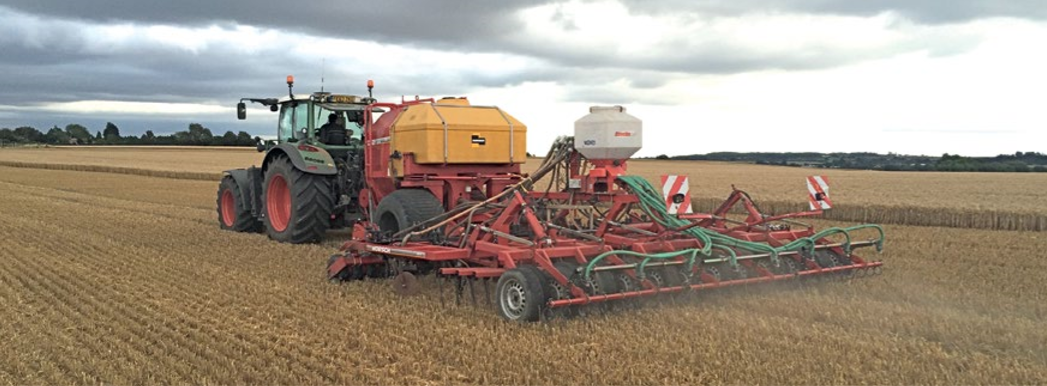
How To Start Drilling For £8K
Clive Bailye’s seed drill of choice is his 6m John Deere 750A , which has been used exclusively for 3-4 seasons. Last year, with an increased acreage, the founder and publisher of this Direct Driller magazine thought a second seed drill was necessary. Having just the one machine was a risk and in a difficult season would mean drilling was delayed. He looked around and found a good condition Horsch CO6 tine drill advertised in Germany.
Words and pictures by Mike Donovan
After delivery he rebuilt the coulters to a narrow profile so as to reduce soil disturbance. He says the tine drill is very useful driling after straw crops such as osr and also through the straw on second crop cereals.
Buying the drill from a German farmer was not particularly complicated, and provided him with a higher spec machine than Horsh sell in the UK. The seed dart tyres are much wider, and the machine is fitted with blockage monitors as well as full width front packers and also a liquid fert application system.
A sheaf of photos were taken, and Clive then asked for some of specific parts to show wear. The deal was done at under £5,000 which Clive says is the market value of these machines which are too large for small farmers to buy. Original owners like to buy new and sell when the machine is still in good condition.
Narrow tines with wear tiles
@Clive knew he wanted to make changes, substituting the Horsch tines and coulters for something far narrower, and has ended up getting his own design of tine made, which has a wear tile made from Ferobide, far harder than tungsten. The drill is on the farm primarily for osr and 2nd crop cereals drilled into chopped straw and the 25cm spacing is okay for these crops.
Comments on Clive’s on-line forum, TFF, said the drill many not be so good with beans, as the slot is a mere 12mm wide. And in barley the spacing may well be too wide as it needs to be thick. Clive points out that the seed pipe can actually be a bit wider than 12mm as it is in the shadow of the point. It would be good to have the option of using it for beans.

Above left: The cheap CO6 is being calibrated ready for its first outing

Above right: The adapted Horsch is being filled by the home built drill logistics trailer with seed and liquid starter fert.
Getting around the German instructions
The Horsch came, of course, with a control box and instructions in German. More on-line discussion revealed that English instructions were available on the Horsch website, and another explained that Horsch was sourcing some of these parts from Agton in Canada anyway. Zealman from New Zealand explained that the button marked with callipers should be held down for around 5 seconds. The menu is where you adjust the tramline sequence, valve layout and row numbers.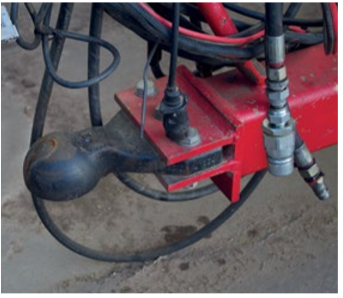
Ball hitch is a continental standard and provides a positive connection between tractor and drill

The Stocks Wizard has a rotor modified for Avadex which otherwise leaks everywhere
A Stocks Wizard is on the back of the drill and used for Avadex. Here again the knowledge of actual farmers is helpful. Alistair Nelson warned that the rotor and the surrounding shroud need to be changed, and he got good advice “from Rick at Stocks”. Clive has the same setup on the 750A and says that the Avadex leaks everywhere unless the modification is made. The drill was acquired and modified in 2016 and the results have been excellent.
The machine went through the residue without many problems and having the second drill has meant more timely planting. Clive has shown that moving into No-Till is not the expensive exercise so many farmers think it might be. The total cost, after modifications which included replacing all tines and coulters, was under £8,000.
Author Mike Donovan writes: we have featured a number of home made direct drills in @Practical Farm Ideas, and are always interested in seeing more. Please contact mike editor@farmideas.co.uk or 07778877514.
-
Why Agriculture Is A Practice And Not An Industry?
Jon Williams provides a fascinating insight into the development of chemical farming, the super-importance of calcium and magnesium, and the limitations of using PH as a guide to fertilising. He ends with a useful soil sampling suggestion
At the end of the second World War there was rationing in the UK and the Government edict to agriculture was to expand food production and farmers quite rightly responded to that call as they always do and particularly in times of crisis. This has been recently highlighted with the Covid Virus raging the country and the shut-down of most industries but agriculture remained resolute and carried on producing food for the nation.
However there is a major difference between agriculture and other industries and food production from our soils needs to be re-classified as “The Practice of Agriculture”.
Why is this so?
Firstly it is important to understand that companies such as ICI were very powerful at the end of the war as they had produced all the raw materials used for bomb making such as TNT (Nitrogen) and Potassium from their mined resource at Cleveland. The call for increased food production resulted in these bomb making ingredients being used for food production. The drive for more and cheaper food is the ethos we have followed ever since and has resulted in a more industrial approach to agriculture involving inputs and outputs and the margin of cost between these two regarded as success or failure of the farming methodology principals followed.
This approach to agriculture has resulted in ever tighter margins of production as the costs of the inputs have risen, and the yields have stagnated. This has been made worse as the hidden cost of the depletion of the natural assets of the soil such as Organic matter have not been accounted for. The result of this is soils used for cropping only, being depleted of organic matter to the extent that 70% of all arable land in the UK has now less than 3% organic matter remaining. This situation obviously cannot continue and if the UK was taken as one large farm it is out of balance with the intensive livestock areas having too much organic matter averaging 9.5% (the results of over 900 soil samples in Wales).
For good soil structure, nutrient holding capacity and good water retention the ideal levels need to be between 5 % and 7% and farmers are increasingly becoming aware that they need to rebuild this organic matter with the introduction of cover crops and re-introducing grassland as part of a rotation with livestock, as well as reduced tillage.
This rebuilding of soil organic matter levels includes the sequestration of carbon as it contains 55% Carbon and moisture retention levels improve, up-to 170,000 of extra water per hectare being held within the soil per 1% increase.
With the emphasis on public good along with food production this can be termed as “Regenerative agriculture” as we develop systems to rebuild soil as well as produce food it is likely farmers who have this intention will receive financial benefits alongside building a more resilient business.
The increasing supply of fertiliser was encouraged by ICI when they set up a company still operating today to carry-out basic soil analysis which was a guide for farmers as to which fertiliser to purchase and a PH reading for liming requirements to ensure a better response to that chosen applied fertiliser. Today it is important to understand that this was a tool to be used to purchase fertiliser only and it is now time to consider a more detailed look into soil analysis for building resilience in the food production process.
With the increasing awareness of impending climate change with rising temperatures and more unpredictable weather patterns it is imperative that we transform our agricultural practices quickly.
To achieve this transition as quickly as possible we need to follow the Albrecht Philosophy of soil analysis which is the result of 36 years of research into soil chemistry and along with soil texture can be used to amend the soil to improve soil structure and the aerobic nature of soil. This method of soil analysis results in a picture being formed of the effect of past management on the soil and can be used as a management tool to take the farm forward for improved crop performance and at the same time sequester carbon.
Having carried out nearly a 1000 of these tests there are several issues which are being highlighted and the first and possibly most important is the realisation that every field can be different according to its past cropping policy and this is why we need to consider agriculture as a practice and not an industry.
The realisation that the soil sampling method is holding back the development of this approach to food production is key to building a more resilient business and that the two nutrients required in greatest volume in soil – Calcium and Magnesium – need to be raised up to 80% on the clay colloid with the balance between the two dependent on soil texture. This incidentally raises the PH and so it is not PH that is the key indicator for successful crop performance but the level of these two major nutrients that governs the response of other elements and enhances crop performance.
pH can be at optimum for ever!
The choice of liming material can be done when a detailed soil sample is carried out and I suggest that all purchases of lime from a quarry need to come with a full analysis as the soil amendment needed may be for Calcium limestone or Dolomitic limestone depending on the existing levels with no more than two tonne being applied at any one time. For major shifts in the levels of Calcium and Magnesium the liming always need to be done in volume, however for small adjustments the liming can be achieved using the granular products now available such as Calci-fert or Mag-fert. The introduction of these relatively new products means that we need never allow the PH of soils to drop below the optimum for ever and the potential for improved crop performance is ensured.
Calcium is “KING” in the soil as it can be considered the trucker that takes most other elements into the plant and the other major nutrient Magnesium has a key role to play in “Nitrogen Use Efficiency” within the plant and so correcting both these nutrients and raising the levels to near to 80% on the clay colloid is a priority and not PH as such, which is essentially a measure of Hydrogen Ions.
More nutrient dense quality food
The adoption of this method of assessing soil quality is key to future proofing the resilience of the practice of agriculture and switches the emphasis away from the industrialisation of farming towards a more holistic approach to food production with the added benefit of producing more nutrient dense quality food. This is highlighted by the fact that 50% of the UK population is short of Magnesium and we ignore this method of analysis to the detriment of our soils, our crop performance and the health of the people we supply with our produce.
Maintaining these two major nutrients ensures that the locked-up Phosphorus in the soil and applied soluble fertiliser Phosphorus is made more available to the plant. The positively charged Calcium will attract the negatively charged Phosphorus reducing the potential for run-off and severe lock up when more Aluminium is present as a result of low Calcium levels.
Farmers need to be rewarded when they produce such quality food and ensuring a fair price is essential for the shift towards the practice of agriculture and away from the more industrialised approach.
Monitoring soil with detailed soil analysis as a management tool.
I suggest farms are split into four areas for the purpose of soil analysis with a quarter of the farm being analysed every year and in year five the process is repeated. This needs to be the base from which to go forward before digital nutrient mapping and variable fertiliser rates can be employed successfully.
Min-Til
To ensure Min-Till is successful a good open structured soil needs to be established via this soil analysis method which when used to balance the major nutrients will produce and maintain a crumbly soil structure which is ideal for slotting in new seeds. So the need for traditional cultivation methods is eliminated and The Rodale Institute of America has been developing systems and machinery to introduce these methods for successful crop establishment on a wide scale including in organic agriculture systems. (therodaleinstitute .org)
-

Deeptill Radish The Living “Soil Drill”
Written by Christoph Felgentreu, Deutsche Saatveredelung AG · Bückwitz
Deeptill Radish (Raphanus sativus), also known as “melioration radish” is a plant breeding innovation. The focus was on a strong rooting performance to combat soil compaction during the crucifera selection process.
The aim of the breeding was to select a strong, aggressively downwards growing root. It should have properties similar to those of lupin roots: downwards vertical soil penetration, if possible even through compacted areas, such as tillage pans. This breeding goal has been achieved to a large extent (Figure 1). Today, Deeptill (DT) is also known to offer many other benefits such as a later generative phase, lower winter hardness compared with common oil radish varieties and faster soil warming in spring. The considerably many other benefits such as a later generative phase, lower winter hardness compared with common oil radish varieties and faster soil warming in spring. The considerably cover crop programme “TerraLife”, as its name suggests, places emphasis specifically on good rooting in the soil.
Warming the soil faster
Another advatange of Deeptill radish is its ability to break up soil compaction and open up the soil, allowing the soil to warm up faster in the spring. Experiments by the U.S. Department of Agriculture (USDA) (Graph 2), were able to demonstrate the advantage of faster soil warming by Deeptill radish in spring. It allows the farmer for instance to sow maize earlier without deep cultivation. Deeptill radish will die quicker than other varieties of radishes (Fig. 3). Very shallow tilling or mulching in autumn can help to secure winter kill, particularly in a mild winter.
TerraLife DT
For the new cover crop season, DSV is offering mixes including Deeptill radish. These are marked with the abbreviation “DT”. These mixes are particularly well suited to limy sites, where lupins don’t grow well or possibly not at all, and combining the advantages of the other components in the mix with those of the radish.

The aim of the breeding was to select a strong, aggressively downwards growing root. It should have properties similar to those of lupin roots: downwards vertical soil penetration, if possible even through compacted areas, such as tillage pans. This breeding goal has been achieved to a large extent (Figure 1). Today, Deeptill (DT) is also known to offer many other benefits such as a later generative phase, lower winter hardness compared with common oil radish varieties and faster soil warming in spring. The considerably many other benefits such as a later generative phase, lower winter hardness compared with common oil radish varieties and faster soil warming in spring. The considerably cover crop programme “TerraLife”, as its name suggests, places emphasis specifically on good rooting in the soil.

Warming the soil faster
Another advatange of Deeptill radish is its ability to break up soil compaction and open up the soil, allowing the soil to warm up faster in the spring. Experiments by the U.S. Department of Agriculture (USDA) (Graph 2), were able to demonstrate the advantage of faster soil warming by Deeptill radish in spring. It allows the farmer for instance to sow maize earlier without deep cultivation.
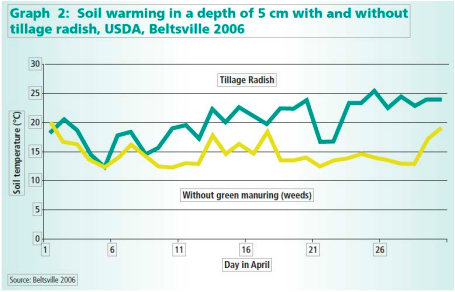
Deeptill radish will die quicker than other varieties of radishes (Fig. 3). Very shallow tilling or mulching in autumn can help to secure winter kill, particularly in a mild winter.
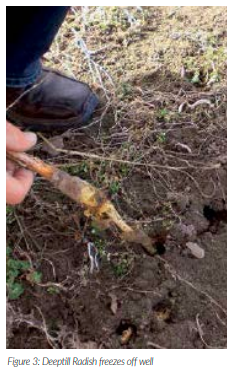
-

Drill Manufacturers In Focus…
SOIL HEALTH BONUS FROM COST CUTTING SOLUTION

Cutting the cost of cultivations was the key driver for arable farmer Chris Marchment when he parked his plough for the final time 12 years ago.
Farming 80ha near Andover in Hampshire, just to the south of the North Wessex Downs, he faces the challenge working with clay-capped soils with flints. Under a conventional cultivation regime, the cost of wearing metal and excessive diesel use had become unsustainable, so he turned to a non-inversion minimum tillage system.
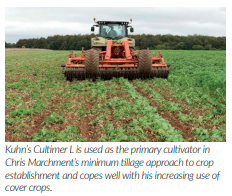
Initially building his own three metre machine, he then progressed to a four metre system where a single pass with a trailed shallow tine and disc cultivator precedes a min till drill. A decade or so on from his initial tentative steps, Chris is not only operating with substantially lower operating costs but is seeing a continual improvement in soil health.
“We’ve now reduced the cost of wearing metal down to around £5/ha and our diesel use for cultivations is in the region of £5 – £7/ha,” he says. “These cost reductions are vital, but its been just as beneficial to see the improvement in the overall workability of the land.”
One of his biggest hurdles when converting to min till was finding the right cultivator for his system. This wasn’t due to any shortage of choice, but more to do with a lack of responsiveness from most machinery suppliers.
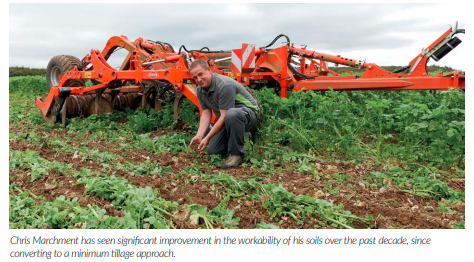
“It was difficult finding anyone willing to demonstrate a machine without some kind of guarantee of purchase or payment for delivery,” recalls Chris. “In the end, I saw the Kuhn Cultimer working at a tillage event and it seemed to offer most of what I was looking for. Within a week of seeing the machine in action Kuhn had arranged a demonstration on the farm and we then had a machine supplied by T.H Whites of Marlborough.
“I’m not aiming to move a lot of soil, so wanted a machine that would create a good tilth within the top four inches. I also wanted a trailed machine, to minimise the amount of weight on the tractor. The Cultimer is relatively light, being as much as two tonnes less than equivalent four metre machines, and yet it is still very strong and well built.
“Run behind a 170hp tractor, we’re able to operate with low tyre pressures of around 12psi, which – along with flotation tyres on other machinery – means we’re reducing the risks of compaction.
“Most important of all is the quality of the seedbed that’s created. When one of my neighbours saw the job the Cultimer was doing he immediately ordered his own six metre machine, it was that good.
The Cultimer has three rows of staggered tines, a row of levelling discs and a rear roller. It’s a versatile machine, offering a range of cultivation depths down to 35cm, but Chris opted for a specification with front depth control wheels and with wings on the tines, so the machine works within the top 10cm of the soil. With his flinty soils front of mind, he also specified tungsten tipped points on the tines and has certainly seen the benefits, as he has from the double spring loaded non-stop mechanical break-back system.
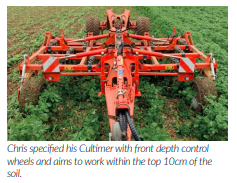
“It’s certainly been worthwhile investing the extra in tungsten tipped points because after close to 1,000ha of work we’re still on the original set,” says Chris. “The spring back safety system really protects the machine and is a particular advantage in our conditions. The system operates with 600kg of pressure at the points, so ground penetration is very good, but when there is an obstruction the leg retracts a good distance and springs back into work immediately. I can cultivate up to 30ha in a day and that’s certainly helped by the efficiency of the spring back system.”

The typical rotation at Foxcotte Farm is a first wheat (yielding close to 10 tonnes/ ha) followed by spring barley, grown for malting, with either winter or spring beans as a break crop. These are now all established with a minimum tillage drill, usually after one pass with the Cultimer, but a second pass is used where a cover crop has been grown.
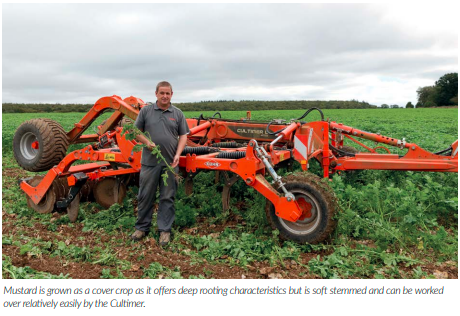
Cover crops, along with the practice of incorporating all the straw, are another important factor in improving the soils.
“We’ve not baled any straw for ten years,” adds Chris, “and we’ve started growing mustard as a cover crop more recently, avoiding where possible any bare soil over winter. The mustard is soft stemmed, and we only allow it to grow to about one foot high, so the Cultimer copes with this perfectly well and allows the drill to follow without any problems.
“It’s all part of building fertility and improving the workability of the soil, and that’s helping to keep the cost of establishment down.”
-
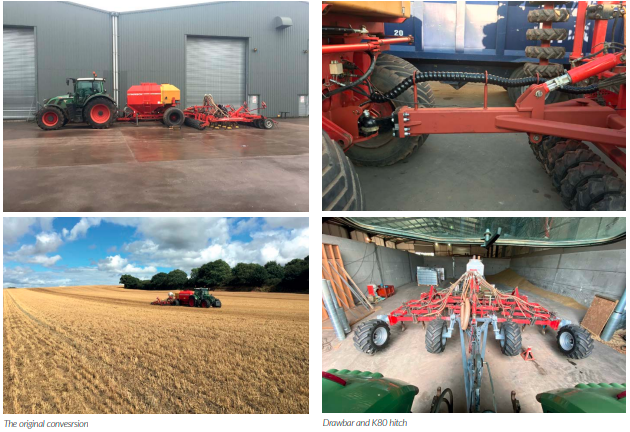
The Evolution Of The £8000 Zerotill Drill
Back in issue one of direct driller Mike Donovan of Practical Farm Ideas wrote about our budget no-till drill in his article “How to start drilling for 8k”. The drill had been bought and modified at the time to run along our John Deere 750a, partly to increase capacity to cope with a seemingly ever expanding workload in constantly tightening weather windows and also to provide a low disturbance tine option, complementing the disc coulter of the John Deere machine,
by Clive Bailye – twitter.com/TWBFarmsThe question of tine vs disc on notill drills has been frequently debated amongst farmers. The disc can cope with extraordinary amounts of trash that would turn a tined drill into little more than a rake yet it some situations the disc can push straw residue into the slot, a process commonly referred to as “hair pinning” with undesirable agronomic consequences for the plant, whilst the tine avoids this by sweeping the seed zone clear of trash.
Coulter designs like the Cross Slot and Novag drills combine the trash handling ability of a disc drill with the slot clearing characteristics of a tine equipped machine but come at a cost both financially and in terms of power requirement, for the direct driller looking for a single drill this design of coulter possible best provides that solution.

Some disc drills are fitted with row cleaners that clear the trash ahead of the coulter, as our farmed area grew and we needed to use both the 750a and converted C06 in situations with hair pinning potential we did ultimately end up with a set of Aricks row cleaners imported from Australia fitted to our 750a, which although a good solution, not a cheap option or always one available to UK farms. The initial modifications carried out to the CO6 are covered back in issue 1 but other than a good service, fitting a 2nd small seed / slug pellet / avadex applicator and conversion to a low disturbance point it was still mostly as it had left the Horsch factory. Since then we have covered many acres with this machine and the modifications have evolved to become what I now think it’s the perfect tine drill solution.
Drawbar
We opted to buy a European spec Co as the seed carts ran a far superior single floatation tyre than the small double castored wheel more commonly specified in the UK. As well as the obvious ground pressure advantage this design was much more stable on the road, the drawback however was a lack of machine following on the road making traffic islands and access to tighter gateways off narrow lanes somewhat of a challenge. The solution was to add an articulation between seed cart and toolbar creating a drawbar with K80 style ball hitch, doing this also created the ability to disconnect the toolbar from the seed cart completely if required and use it in the front hoper configuration described later in this article.
Conversion points
The drill was originally converted to low disturbance using Metcalfe points, these 12mm points provided a very low disturbance solution, however on our higher stone content soils they often lost the tungsten tip leading to premature wear, the seed tube was too narrow to flow large seed like peas and beans without blockage so needed upgrade to their larger tube diameter which was prone to rapid wear. To try and address these issues we set about making our own version, slightly wider at 15mm and using Ferobide wear tiles rather than the tungsten of the Metcalfe, the logic being that the Ferobide could be replaced if it broke off using farm workshop Mig welder rather than specialist induction welding that is required to reattached tungsten. We also added a slide plate to these farm designed points to protect the seed tube all of which gave a significant improvement to reliability and wear but at the cost of much more soil disturbance.
The other commonly used conversions for these drills are the Dutch Industries coulter and the Bourgault VOS (Versatile opener system) both offer a similar cast point with seed (and in some versions fertiliser) delivery run internally through the casting. Having run a test of both brands the Boulgault seem the better option, no only did it seem to wear better on our soil types but it offered more options for both solid and liquid fertiliser placement and a range of seed banding widths.
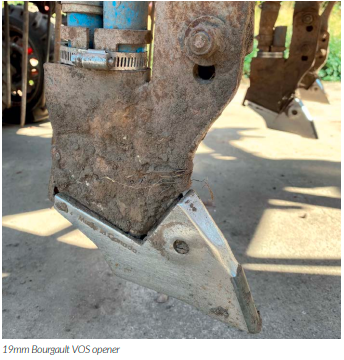
Possibilities with this coulter seem endless and open opportunity for companion cropping, seed and fertiliser banding and biological liquid placement separately or in the same slots. We started off using the 75mm twin band point which was very successful but in the terrible wet conditions and late drilling of autumn 2019 we moved to the single row 19mm point. I doubt we would have had half the area planted if we hadn’t used it. This point seems to be the sweet spot for us and I like the 250mm row widths which are the same as our Avatar disc drill. For farms with more challenging grassweed issues than we have I can see the wider twin row versions of this point would be a excellent solution. As well as the performance the wear rates seem low so I do not think we will look any further in the future than the VOS opener.
Packers
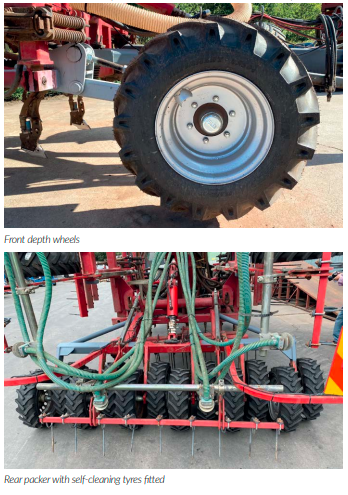
Our CO6 had clearly been loved by its previous Polish owner who had made several upgrades. Not only had they converted the rear packer to the later, more reliable sprinter style bearings but they had fitted a front packer to the toolbar. Such a front packer would have been ideal when the drill was used on cultivated land providing some consolidation ahead of the seeding. But in a none disturbed no tillage situation it was somewhat redundant. However when the drawbar conversion was done it served a new role in providing depth control at the front of the machine so was retained.
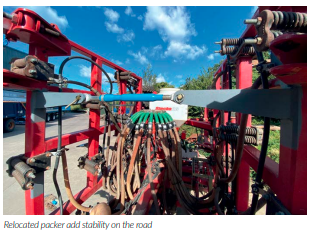
The tyres were a small diameter which in wet conditions could struggle to keep turning, they were also quite worn, punctures and a few tyres with damaged sidewalls ultimately made it more economic to replace its depth control role with 4 larger diameter wheels, we used the same size wheel and tyre as fitted to our 12.25 Horsch Avatar giving us a universal fitting spare.

The rear packer ran the standard CO car pattern tyres that were again getting quite worn and were less than ideal in wet conditions so these have now also been replaced with a similar size BTK tyre with a self-cleaning tread pattern again helping with wet condition performance.
Safety and stability
With the addition of the drawbar the stability of the machine when folded was reduced, the high centre of gravity less anchored by a fixed linkage. The solution was to remove the first packer axle from each of the vertical wings and reattach it to the centre section, giving a wider, more stable wheelbase but still within the 2.95m road legal transport widths. Another small addition has been the addition of a fixed top link locking bar to hold everything securely on the road and not rely on hydraulics or straps.
Front Hopper
The move to having drawbar connection between seed cart and toolbar offered the possibilities of running the drill with a front hopper rather than the large seed cart. This offered the advantage of a much-simplified machine with far better visibility of the toolbar for the operator along with enhanced weight distribution and 2 less tyres on the ground. This created a drill that’s wet weather performance is truly exceptional and was able to complete 100% of our 2019/2020 workload through record wet conditions. The combination of undisturbed soil, optimal weight distribution over as few weight carrying tyres as possible and the low disturbance coulter allowing the rear packer to run clean without soil contact. All worked together to establish crops successfully through a very difficult season.
The hopper we chose was the Horsch Partner, this fully ISO hopper uses the same control software as our Avatar and incorporates the same blockage monitoring system so is familiar to operators. Like the Avatar it’s a very simple one man operation to calibrate and has metering and fan capacity to cope with a 12 m toolbar giving us options to use it with the Avatar (giving ability to drill up to 6 products, meaning less pre missing of cover crops ) or with other 12m wide seeders in the future fitting in with the 12/36m control traffic farming system we operate. The hopper can be split into 2 products giving seed / fert or companion cropping options which with the versatility of the Boulgault openers creates a new word of possibilities!
Costs and Conclusions
Of course, over the years of development the cost has now moved on from the original £8000 spent buying and converting the drill, approximately an additional £6000 was spend on drawbar, opener, and packer conversion. The seed cart has been sold offsetting some of the cost of the front hopper the cost of which can be anything from £1000 for a well-used Accord unit at a farm sale to £20,000 plus for a fully specified ISO 2 product unit with blockage monitors

It’s taken us 4 seasons to fully develop this machine to where it is today, even after the additional spend it offers a relatively cheap and versatile no till tine drill that agronomically complements our Avatar disc drill, gives us additional capacity and offers a degree of insurance against wet conditions. It shows you don’t always need to spend huge amount on a new machine to direct drill. All it needs now (this winter’s project) is a sandblasting and a coat of shiny paint to smarten up all than “development mule” primer !


-

Feeling Tired?

If you are serious about reducing soil movement to reduce costs in fuel and labour without reducing yield through compaction what are your options, and how do you ‘dip your toe’ without financial commitment? “Just looking thanks” is the phrase while on a manufactures show stand whilst trying to form your own opinion. How do you do a bit of non-bias research on system change on your farm? AHDB’s Monitor Farm meetings are one way, either on-line or in the future back to face to face meetings. But again how do you build a system for your farm, based on your soil type, your area to be covered and time available to you?
To gain an idea of the size and width of a direct drill whatever design you choose you can look up the AHDB Machinery Calculator and mess with the width, forward speed and field efficiency (time spent actually drilling rather than turning and filling) and come up with a drill width to suit you. If the numbers don’t stack up, up the speed or more hours per day, eventually you will come up with a consensus of what you need.
But as the power needed increases so does the weight of tractor need to pull the drill. Can you assess the level of compaction going in below where your chosen drill is working? Based on the weight on the tyres, soil type and soil moisture, yes you can.
Terranimo is a website where you can select the tractor/implement combination or crop sprayer, combine harvester, beet harvester, Potato harvester, forage harvester for that matter. Select the tyres, calculate the weight on each tyre, select the soil type and soil moisture and calculate the depth of compaction based on the data you have entered. Hey presto you can generate a detailed report on your chosen set up. And, like the machinery calculator, if you don’t like what you see, change the numbers and try again. Nothing ventured and all that.
For the lucky living in Scotland the soils data is already entered, just pick your county and the soil data at 10cm steps to 150cm depth is available. Choose between dry, moist, and wet for your soil water content and choose if you plough and cultivator or not. For those not living in Scotland work is on going to bring England into the fold, but for now your soil type can be entered manually.
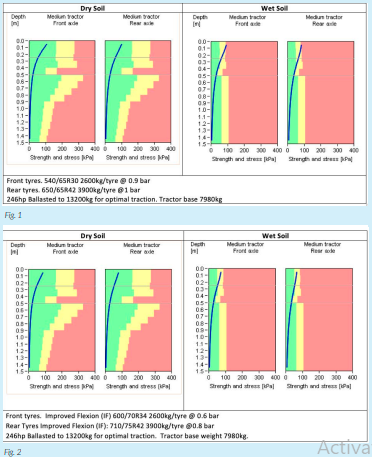
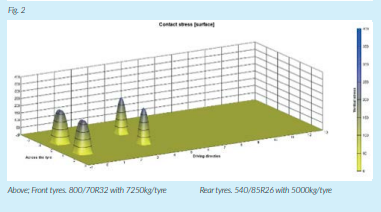
Of course, those reading these pages will be keen to remind of increased soil organic matter and higher magnesium content in clay soils would help too. But for now, lets keep it simple.

In choosing tyres there are over 800 tyre sizes, brands and designs to go at. Twin track and four track tractors are in there too. But I’m not pretending every brand and combination is achievable and the very latest tyre on the market may not be present. The website is the work of Aarhus University in Demark and the AHDB have been funding its availability in the UK.
So, looking at a typical 246hp drill tractor (Fig.1), if it is ballasted to achieve full traction then the graphs below represent the soils ability to carry the weight of the tractor on the tyres selected. The blue line represents the tractors front and rear axles and the boundary between green and yellow corresponds to 75% of the calculated soil strength, and the boundary between yellow and red shows 125% the soil strength. In the wet soil condition graph both front and rear axles reach 125% to a depth of 10cm and compaction is still ‘going in’ at 50cm. In the dry condition graph, the soil is able to support the tractor without undue compaction.
If the same tractor is fitted with wider IF (Increased Flexion) tyres, (Fig.2), then things improve. But it must be stressed that the tractor is fully ballasted for full traction, so its unlikely in the real world to need this level of ballast for drilling.
Looking at a 125hp tractor fitted with the optional wider tyres (Fig. 3) shows similar characteristics to the 246hp tractor on IF tyres and of course this is fully ballasted, worst case scenario. Removing the ballast, sheds almost 30% off the tractors weight.
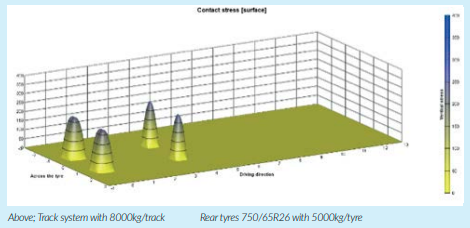
Choosing whether to go with tracks or a wheeled machine for your next combine? The Contact Stress function can point out the peak pressures from wheeled or tracked combines. Below is a typical large wheeled combine with 9-metre header fitted. With both grain tank and fuel tank full the front axle comes to 14500kg with 10000kg on the rear axle. Note the rear axle in this case is exerting more stress on the soil the front axle.
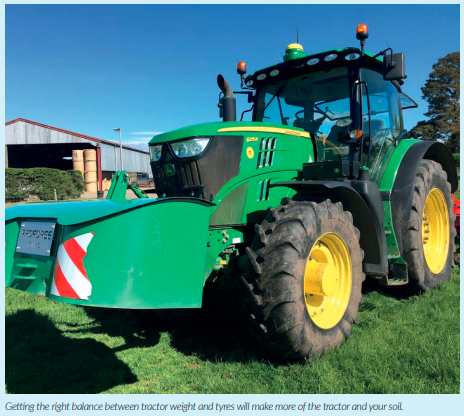
The same combine with the track option fitted show a marked improvement in soil stress, the front and rear rollers with two centre idlers exerting the peak pressures. This combine is also fitted with much larger rear tyres but still exert more stress than the track unit. Both combine calculations here used Dry Soil. But of course, this is not always available. Just as an illustration we have sent our fully leaden wheeled combine into wet, clay soil conditions. As you can see below the front axle did not find soil able to support its weight until at 50cm depth and the rear axle is little better. Yes, the combine is stuck. And if this where real, que the social media fest.
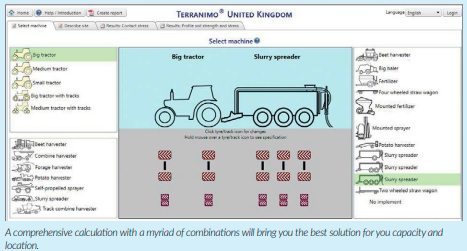
Obviously, the examples I have shown here, while real, are not likely to be what you need. So, get the kettle on, forget Strictly goes Dancing and have a go at calculating the right tyres, power, indeed farming system for your future.
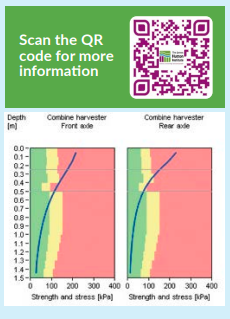
-

Will It Work For Us?

Andrew and Sam Melton, new to the AHDB Monitor Farm programme this year, are looking at how to make cover cropping and direct drilling work on their soils at Wisbech, Cambridgeshire.
Farming silty clay loam soils and with a keen interest in farming sustainably, whilst improving yields and productivity, Andrew and Sam Melton have kept a keen eye on the developments in cover cropping and direct drilling over the last few years. Seeing how other farms have made the successful transition to using cover crops and shallow tillage, Andrew and Sam, the father and son team, invested in a new direct drill (John Deere 750A) last season and are now interested in how to get optimum output from the drill, soil and the crop itself for their business.
The Melton’s farm 1,400 hectares of silty clay loam soils near Wisbech, Cambridgeshire. Their rotation includes wheat, barley, winter linseed, beans and sugar beet. The farm currently operates shallow tillage and full inversion cultivation systems, but have been looking at reducing soil tillage.
Joining the Monitor Farm programme in June 2020, one of the areas that Andrew and Sam are keen to focus on is incorporating cover cropping and reduced tillage into the rotation. To start on this journey, this autumn, the Melton’s are doing a try-out and testing three different cultivation methods:
1. Plough with a 7F Gregoire Besson
2. Shallow tillage using a Vaderstad Carrier with cross-cutter discs
3. Direct drilling with the John Deere 750A
The three systems have all been trialled alongside each other in a field, which was winter wheat last season. Following the combine, a catch crop (buckwheat, millet and sorghum) was established on some of the tramline plots but not where ploughed.
In addition, the shallow tillage area has a section with and without straw. Andrew is interested to test which of the systems works better for managing straw residue, something that he is keen to get right for optimum establishment.
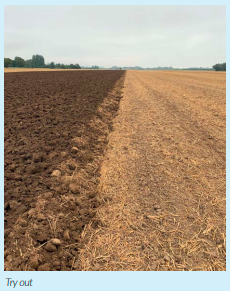
In this way, one part has been chopped and the second section baled and removed. Measurements will be taken across the try-out areas through the season, including a look at soil (soil analysis, resistance, infiltration and structure), residue (levels left on the surface after drilling) and plant measurements (emergence, canopy cover, plant, tiller and ear counts, NDVI and yield).
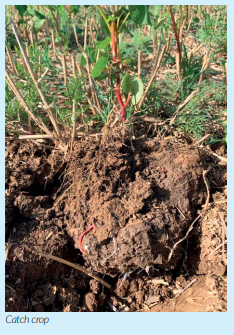
The farm business also actively uses technology throughout all operations and to effectively manage fields and areas. As part of this try-out, fuel use and machinery telematics will be analysed to look at the impact of the different cultivation methods, alongside an analysis of the costs of using the different establishment systems. Building on previous farmer experiences, existing industry research on cover crops and now having the opportunity to try this on-farm, it is hoped that this will start to build a picture of how the Melton’s can best employ this system effectively for their business in the future.
Results will be shared in a future issue.
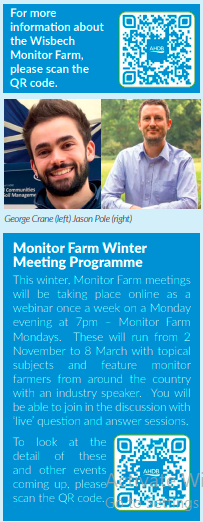
-

Arbuscular Mycorrhizae All Greek To Me!

In this article, Jason Pole explores the crop-friendly fungi focus of one of our crop PhD studentship projects, funded by AHDB Cereals & Oilseeds
If your crop roots are in good nick, there’s a decent chance they’ve cuddled up with some potentially powerful soil allies: arbuscular mycorrhizal fungi (AMF). The word ‘mycorrhiza’ stems from two Greek words: mykos and rhiza, which mean ‘fungus’ and ‘root’, respectively. Unlike fungal pathogens, which infect and damage plants, AMF form symbiotic relationships with roots – in a healthy game of give and take
AHDB PhD student George Crane has developed a fascination for AMF, which are ubiquitous in nature. AMF colonise root cells, undergo intense branching and form ‘arbuscules’ – sites for fungus–plant metabolite exchange and nutrient accumulation.
Based at NIAB, George leads on a series of field-scale trials and glasshouse experiments that aim to tap into the potential of AMF for crop production.
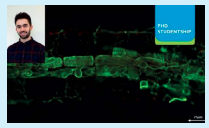
As part of a UK soil assessment programme, the effect of common farm practices on AMF diversity and abundance has already been examined. For example, deep cultivations influenced AMF species composition, with disrupted soils potentially hosting fewer beneficial species.
Cover crops, which deliver various benefits to farming systems, can also promote AMF. This aspect is under investigation in two fully replicated trials in Norfolk (Bawburgh and Morley). Various cover crop species are being tested – sometimes with a helping hand in the form of commercially produced AMF inoculum (five species).
The study has also linked with Innovative Farmers (IF) too, to apply these findings at the farm scale. The research is providing a steer for onfarm trials at six sites that use cover crops and anaerobic digestate (AD) to influence AMF. So far, all trials have delivered mixed results. However, longterm use of cover crops is most likely to deliver a positive effect on AMF communities.
The work has also refined the use of targeted primers that amplify specific AMF DNA. Such molecular approaches can help detect the presence of fungal species in soil samples. For example, George’s work has confirmed the presence of 87 AMF taxa in the UK soil assessment samples, which will now be further investigated.
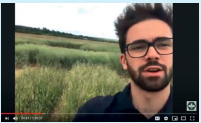
With UK farming under increasing pressure to demonstrate its sustainability, AMF provides another great opportunity to harness and work with nature. The PhD, which receives part funding through the AgriFood Charities Partnership (AFCP), is due to conclude next year.
For more information:
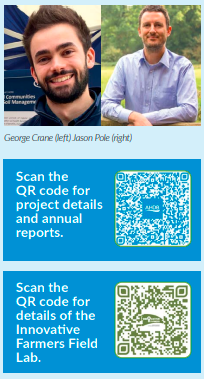
-

Drill Manufacturers In Focus…
ESTABLISHMENT COSTS V RETURN

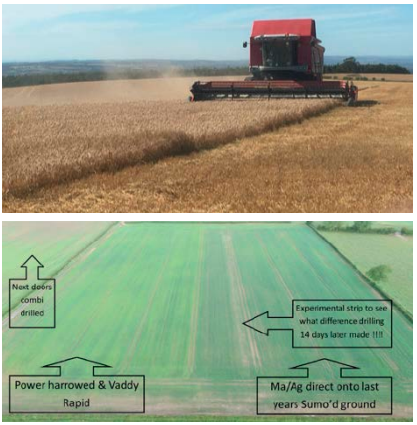

For once weather conditions were similar around the country, poor conditions in the backend of 2019 leading to a lot of ground remaining undrilled or those that had been, failing due to water logging. A late start in spring thanks to prolonged rain on heavy land delayed drilling until well into April, then it stopped and didn’t start again until most crops looked as though they had just about expired. The plants then decided that with a bonanza of water they would “wake up” and put their new found energy to great effect and a late surge of secondary growth led to crops looking much improved but meaning a late harvest and very uneven ripening.

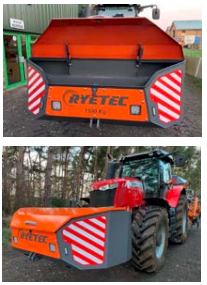
Interestingly we had a trial field of Spring Oat, drilling 5 acres with the farms conventional system of power harrow followed by a Vaddy, to the other 5 acres drilled direct onto last backend sumoed ground which had been successfully treated with roundup. All drilled the same day, unfortunately due to operator error a 4.8 metre strip was missed the length of the field in the direct drilled plot (more on this later). The two crops emerged at the same time, thanks to the Vaddys narrow row spacing and even colour of the freshly cultivated soil the crop appeared to have a much better coverage/emergence than the direct drilled crop. But as the crop grew in the dry conditions whilst the direct drilled crop remained a healthy dark green virtually until the rains finally came, the cultivated crop look thoroughly sick, yellow and with every wheeling of the previous operations evident.

Certainly next doors conventionally worked and drilled field (inset) doesn’t look any different to Ma/Ag direct drilled the same day with double the horsepower per metre!!!
We just now need a bit of warmth to get things moving
In order to widen the appeal of the Ma/Ag drill and offer a much more price competitive units for smaller farmers and contactors wishing to start down the direct route, we have launched ready for Spring (when it arrives !!!) a 3 metre mounted version of the Ma/Ag drill. Utilising the same fully floating coulter unit with its twin disc design, including scalloped straight disc and angled plain disc with a rear rubber press wheel.
If you want to carry tools, fuel or perhaps some cover crop seed, maybe you should treat yourselves to a WorkBox ideal for anyone who needs to have a workshop in the field?
The lid is waterproof and dust proof so every angle is covered, although dust seems a way off at the moment !
More details on drills or Workboxes
contact Ryetec on 01944 728186 -

Tyres In Focus…
COMPLETE TYRE PRESSURE SOLUTIONS
Written by Chris Dolman from Michelin UKMichelin is introducing its latest agricultural tyre technology into the UK with the launch of Zen@Terra for high-powered tractors – enabling farmers to easily adjust tyre pressures for heavy road and field work.
Designed specifically for fitment in combination with a central tyre inflation system (CTIS) and Michelin’s Ultraflex tyre range – although it can be used with any Michelin agricultural tyre – Zen@Terra connects directly into the tractor’s ISOBUS system. Once installed, it allows farmers to switch between low pressures, for maximum soil protection, and higher pressures, to maximise performance on the road. The process takes a matter of minutes and can be operated via an easy-touse, integrated in-cab touch-screen display.
Pre-programmed settings allow the user to tailor pressures depending on the implement attached and vehicle usage. Pressures can be adjusted for empty, half or full loads, as well as slope work. A ‘boost’ function sets extreme low pressure for three minutes, when extra grip is needed.

Compatible with most modern tractors, it is the result of years of research and development by Michelin’s team of expert engineers and, following successful trials across Europe, Zen@ Terra is now being rolled out to farmers and contractors across the UK.
Mark White, Michelin’s National Sales Manager – Agriculture & Construction, says: “Michelin is determined to keep helping farmers get the absolute maximum performance from their machinery
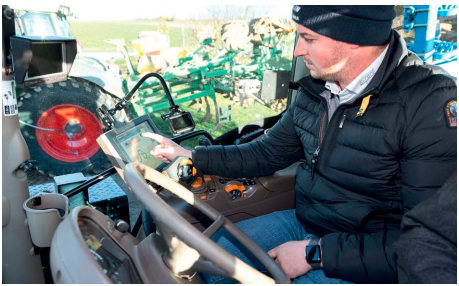
“Zen@Terra is a complete solution, managing all aspects of tyres and their interaction with the ground, both in the field and on the road. “Using an in-built CTIS and our Ultraflex technology tyres, the customer can quickly change tyre pressures to best suit the ground they are working on. This helps to optimise the performance of their vehicles, increases tyre life, improves productivity and yields, while reducing fuel costs and protecting the soil – all of which supports Michelin’s core value of sustainable mobility.”
The system has been developed following direct feedback from farmers and contractors, with Michelin focused on developing a solution offering maximum quality and reliability. The in-built CTIS was designed in conjunction with PTG – industry leaders in tyre pressure control systems – which Michelin acquired in 2017. Zen@Terra can be used with any Michelin Ultraflex agricultural tyres; including Michelin’s AxioBib, AxioBib 2, EvoBib and XeoBib fitments. It will be fitted exclusively in the UK by approved supplier TractAir – a family-owned company which designs, manufactures, supplies and fits air brake systems, air compressors and tyre inflation systems for agricultural applications.
-

Drill Manufacturers In Focus…

This year has been an incredibly busy year for us. We sent our first DSX seeder to our customer in February 2020 and have now manufactured over 20 which has been a huge effort from our team.
We now have DSX seed drills in the UK, Tasmania, New Zealand, Germany, Denmark and France. We also build planter frames, planters and soon strip-till units. We have faced a global pandemic that has not been seen before in recent history. Supply issues have been there to be dealt with – and that has not been helped by one of the wettest autumns on record which led to earlier demand for sold seeders. We are a UK company based near Spalding in Lincolnshire. We firmly believe in employing local people and as such we are a significant employer in our local area.
We invested over £500,000 in a semi-automatic blast and paint line, we did this to ensure a high end premium finish that the major OEM’s are using. This preparation and paint process forms part of our whole business model, to produce premium, long lasting machines that are upgradeable over time. We believe this is the future in machine manufacture to allow the entire agricultural industry to become more sustainable and to counter the ever-increasing operation costs.
Our assembly hall works on a bay principle. We aim to have all the parts arriving in the bay for each machine just as the assembly team want to assemble them onto the seeder. This requires a lot of coordination with our purchasing department as the only thing that is the same about every seeder we build is that each customer has a different specification.
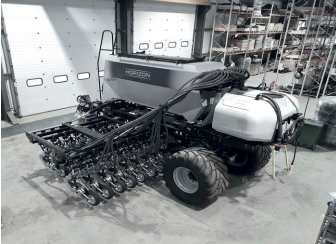
Once the machine is assembled, we then spend a day inspecting it. The machine is connected to a hydraulic test rig and every function is checked to ensure leak free operation. The machines controller is programmed ready for delivery – with all electronic functions also being checked.

We are passionate about the entire manufacturing process from design to PDI and although it has not been easy to setup so quickly, we have a great team and are proud to be where we are today. There is a great ambition I feel pre and post Brexit for the UK manufacturing industry to thrive and it has been great to see British farmers choosing British made products. The DSX has been designed to be modular.
This means that should your needs change you can add or remove parts to the machine. It could be that you need to go up a size and make your 4m machine a 6m machine. We can sell you the parts accordingly so that you do not need to purchase a new seeder. Same goes for liquid, row cleaners and automatic downforce. When we did this we realized that we would need to make the seeder long lasting and robust. It’s been designed with high quality bearings, bushes and parts as possible to ensure a good longevity.
We back all of our machines with a two year manufacturer’s warranty. We carry a good inventory of stock ensuring that most crucial parts can be supplied on a next day basis. We have invested heavily in our people and have a dedicated service and parts team.
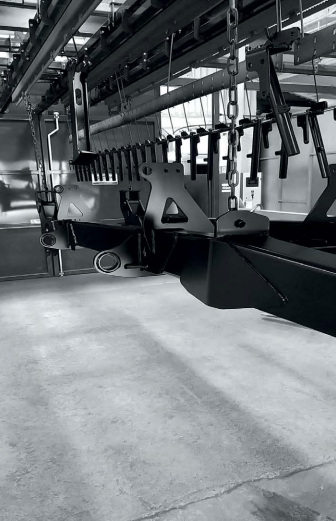
It is very important to prove and demonstrate the agronomic advantages of our opener and options. We have to give the user a return on their investment and as time goes on we will run studies and detail results on our website which will be independently verified. We also hope to welcome people back to our farm for open days when restrictions lift. We wish everyone the best for this autumn drilling campaign!
If you would like any further information about our products please get in touch with us. Our contact details are as follows:
Sales + technical advice:
Tom Carnell (UK)
Tom.carnell@horizonagriculture.com
Mobile: 07487 387265Service:
Jon Gray
Jon.Gray@horizonagriculture.com
Mobile: 07551 908595Spare Parts:Lee Graves
Lee.graves@horizonagriculture.com
Office: 01945 440999
Mobile: 07368 237149 -

Methane And Microbes
Written by Sally Morgan who edits Organic Farming magazine smorgan@soilassociation.org
With ruminants getting bad press at the moment over their methane-filled belches, Sally Morgan looks at the science and the critical role of methane-eating microbes

Are ruminants really to blame for the rapid increase in methane levels over the last decade?
There is no denying methane is a significant contributor to climate change. Its global warming potential is said to be as much as 28 times that of carbon dioxide, but it has a much shorter life of around 12 years. The concern about methane is the sudden surge in levels since 2008. It came out of nowhere and scientists are still unsure of the cause. Current levels are just under 1,900 parts per billion, contributing an estimated 20 per cent of total atmospheric warming to date.
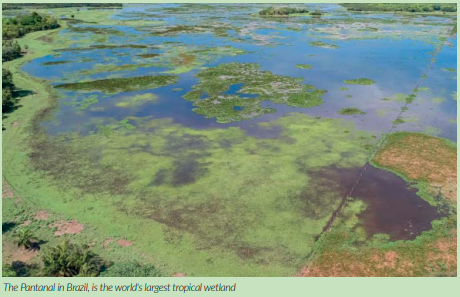
Commentators have been quick to put the blame on ruminants, a blame game that started back in 2006 when the UN Food and Agriculture Organisation published a study entitled Livestock’s Long Shadow. The study claimed that livestock production was responsible for 18 per cent of all greenhouse gas emissions (a figure which has since been revised down considerably). Since then, many organisations have called for a reduction in meat consumption and a switch away from extensive systems to intensive ones, in which animals are raised quickly on grain and soyabased diets that generate less methane. However, it’s becoming increasingly apparent that the methane story is far from clear cut.
Methane sources
There are various sources of methane, both natural and anthropogenic, with the latter being responsible for about 60 per cent of global methane emissions. Methane is released by microbes called methanogens during microbial decomposition of organic matter, especially that which takes place under water in anaerobic conditions as found in wetlands and paddy fields. It’s also released by microbes living in the gut, in particular, the rumen of ruminant mammals and the gut of insects, such as termites.
Methane is released during the decomposition of natural gas, the so-called geological methane, which is stored in underground reservoirs and reaches the surface via seepage, geothermal and hydrothermal activity etc, along with climate-active ethane and propane. Other sources include fossil fuel extraction, fracking, mining, landfill, waste management and the manufacture of nitrogen fertiliser (see Organic Farming 131, Summer 2019).
Interestingly, atmospheric methane levels did not rise between 1999 and 2006 despite a 70 per cent increase in livestock numbers and looking further back to times when vast herds of ruminants were grazing grasslands across the world, methane levels ranged between 350 and 750 ppb. So what’s caused the dramatic rise over the last 12 years? There’s much finger-pointing. Some put the blame on leaks from gas fields, while recent research from Cornell University puts the blame on the boom in the US shale gas and oil industry. Discovering that the chemical fingerprint of methane from fracking differs from that released by traditional fossil fuels and livestock, researchers were able to track the source. They claim that as much as a third of recent methane emissions may come from shale gas development. However, others suggest that tropical wetlands are the only source large enough to explain the sudden rise.
Methanotrophs
It’s not just methane sources that are important; we need to know how much methane is oxidised to carbon oxide and water. This happens naturally in the lower atmosphere but there’s another methane sink of interest, a group of microorganisms called methanotrophs. These are single-celled organisms, such as bacteria, that consume methane as their source of carbon. They can be aerobic or anaerobic and are usually obligate, which means that methane is their only carbon source, so they are particularly common in places where methane is produced. Without them levels of methane would be much higher. In fact, half the methane released by wetlands may be taken up by methanotrophs and oxidised (Dunfield, 2007).
Boosting methanotrophs
Little is known about the soil-living methanotrophs. We know they are found in a range of soils and survive on low levels of methane and that soil management affects their numbers. In conventionally managed soil, the continued application of inorganic nitrogen fertiliser reduces the capacity of soil to oxidise methane and this is linked to reduced numbers of methanotrophs, whereas organic sources of nitrogen, such as manure, enhance the ability of soil to oxidise methane (Brady, 2002). Tillage and other soil disturbance will also adversely affect their populations, reducing numbers by as much as 80 per cent (Evershed, 2012). So, to boost methane oxidation, soils must be well aerated, and tillage and the use of inorganic nitrogen sources avoided. Also, research on alpine meadow soil found one group of methanotrophs to be strongly boosted by the grazing of cattle (Abell et al, 2015).
Livestock emissions
Ruminant emissions vary, even within species. Cattle, for example, produce between 164 and 345 mg of methane per day, with cattle on high-fibre feed producing more methane than those on a grain-based diet. But, as always, the whole picture has to be considered. Grain-fed beef animals may emit less methane, but overall, the energy required to finish these animals is twice that of pasture-fed, because of the use of fossil fuels in growing, harvesting and transporting grain, with additional greenhouse gas emissions from the manufacture and transport of nitrogen fertilisers etc. So, when looking at the lifecycle, it’s important to offset any methane production with sequestering gains; a well-managed, rotationally grazed permanent pasture will sequester carbon, so helping to offset methane production by the animals.
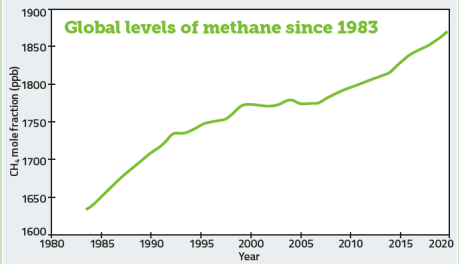
Plenty of lab-based studies have measured methane in a cow’s burp, but this takes no account of its lifestyle. When they are on pasture, head down and grazing, a burp of methane soon gets mopped up by methantrophs living in the soil. If you have a well-managed pasture with a soil rich in microorganisms, methane is not so much of a problem. But place them in unnatural situations, such as vast feedlot in the US or on a poorly managed pasture in the UK that is regularly fertilised, you disrupt the system and the soil will be less able to deal with methane.
Simply tweaking the diet can result in fewer methane emissions: for example, the feeding of sainfoin silage, adding more oil or seaweed. Biochar, too, may have potential. Research shows that biochar can increase the ratio of methanotrophs to methanogens in paddy fields and a similar process may occur in the rumen
Intensive systems
Many overlook the role of intensive livestock operations. Animal waste from intensively raised pigs and large dairy operations is typically stored in lagoons and slurry holding tanks, where the anaerobic decomposition of the organic material produces methane (as well as nitrous oxide which has almost 300 times the GWP of carbon dioxide). This can be avoided if the slurry is fed into an anaerobic digester and the methane captured, or the manure is spread on to heathy soil where dung beetles, earthworms and other soil life can pull it into the soil to be worked on by decomposers and the carbon locked up. Under these systems there will be no significant methane production (FAO, 2002).
There is no easy answer to the livestock question. I don’t think anybody wants a shift to highly intensive systems with all the welfare issues that would result, but without livestock, we’d need more plant crops and they require nitrogen. A lack of manures would mean more land under fertility-building leys or more inorganic nitrogen fertiliser which has a major role in the methane story. It’s a complex situation, whatever food type is producer, there are methane implications.
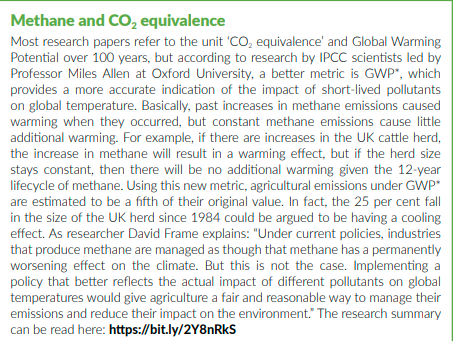
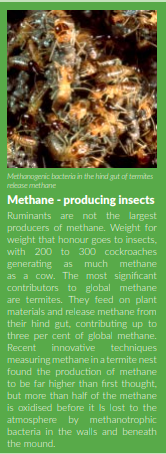
-

Drill Manufacturers In Focus…
COLLECTING AND MANAGING DATA

Farmers have to collect a large amount of data to manage their farm and for documentation requirements. With the ISOXML standard it’s possible to transfer field data from machine displays of the most popular manufacturers to the John Deere Operations Centre. In this way, John Deere is able to support customers that work with mixed equipment fleets.
Data commonly recorded by farm machinery includes field borders, application rates and crop yields, with the information helping farmers to operate more efficiently, cost-effectively and sustainably. However, customers with mixed fleets have often failed to successfully transfer and merge such data into as few software solutions as possible in the office.
The John Deere Operations Centre enables farmers and contractors to exchange different data formats, and there are several ways to transfer data from the machine to the Operations Centre:
• John Deere machines are connected directly and wirelessly with the Operations Centre via JDLink Connect, without any additional costs. Depending on the application, the data can be viewed in the Operations Centre in almost real time and work progress can be measured. Alternatively, the operator can use a USB stick.
• Field data from machine displays that use the ISOXML format can be transferred to the Operations Centre from the beginning of August, but a USB stick is needed for the exchange. Historical machine data can also be included if still present, for example when stored on a computer.
• Proprietary data from other machine displays can be sent to the Operations Centre via a USB stick. In addition, data can be exchanged via a smartphone using a dedicated memory stick. The data can be forwarded from the phone to the Operations Centre using the John Deere MyTransfer app.
• Manual documentation of field work is also possible. This helps for example when collecting information from machines without a documentation function, or if the driver has forgotten to start the documentation process. In this case, all data can be typed into the MyOperations app on the smartphone. Manual documentation via the app is currently available for soil preparation, drilling and crop care applications such as fertilising and spraying, with harvesting data to follow shortly.

In addition to seasonal machine documentation, the Operations Centre user receives a comprehensive digital field book. Customers can view and manage all data from any location using a computer browser or smartphone. The John Deere Operations Centre and MyOperations smartphone app are free of charge. In addition, the exchange of data from various sources does not involve any fees for farmers or contractors. John Deere dealers can provide further information on compatible displays plus the various data formats and transmission options available.

-
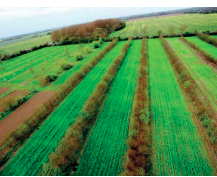
More Support Required For Agroforestry
Written by the Soil Association
A survey of 346 people interested in agroforestry reveals much greater support, information and payment certainty are needed for farmers and land managers to implement agroforestry in the UK. Planting trees on farms can boost farm productivity by 30%[i] and bring a range of benefits including improved soil health, carbon capture, biodiversity and animal welfare. It would also support Government tree planting targets.
Respondents were asked to complete the survey after downloading the free Agroforestry Handbook, produced in collaboration with the Soil Association and the Farm Woodland Forum to help farmers decide which trees and systems are best for their farms. The handbook gave most farmers more confidence to implement agroforestry, with over 75% of respondents more likely to implement agroforestry on their farms after reading the guide. Respondents’ most common motivations were increased biodiversity, landscape resilience, and farm resilience.

However, despite strong interest in the benefits of agroforestry for farms and the environment, the survey found significant barriers holding development back, including a lack of technical knowledge and uncertainty around support payments. Around 40% of respondents did not know where to go for further guidance on agroforestry, with many others finding that the information they need from government simply does not exist.
Ben Raskin, Head of Horticulture and Agroforestry at the Soil Association, said;
“The UK is amongst the least wooded countries in Europe – with only 13% of the UK under trees compared to 38% on average in Europe. Planting more trees on farms can be a win-win for climate, nature and health and would support the huge ambition of the Government’s National Tree Strategy. The UK is already well behind on our Government’s own targets and there’s been other issues, like the potential impacts on wildlife. It’s critical for nature and climate that the right trees are grown in the right places.
It seems a no brainer for UK government to provide a supportive policy framework and more clarity on payments in order to increase the uptake of agroforestry. Tree planting can and must play a vital role in a green recovery – tapping into the strong appetite for agroforestry could support more resilient farming, and help restore nature, health and a safe climate.”
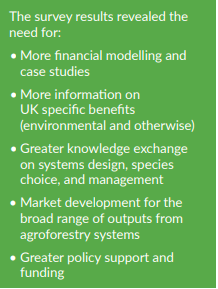
Dr Tim Pagella, Lecturer in Forestry at Bangor University and co-author of the Agroforestry Handbook, said:
“Agroforestry is a new name for an ancient practice. Trees have potential to play a critical role as we move towards more sustainable and ‘climate smart’ food systems. Careful integration of the right trees onto our farms can improve soil and animal health, create diversification opportunities, enhance biodiversity, reduce inputs and deliver public goods in our rural landscapes.”

Survey respondent and Woodland Consultant, David Cracknell, said:
“One silver lining of Brexit should be that we can now shape our own domestic agricultural grants scheme so that we pay farmers to plant trees on their livestock farms – to improve soil, carbon storage, livestock well-being, productivity and the environment as a whole. With the right political will we could really lead on agroforestry in this country. We have the expertise.”
The handbook also highlights opportunities for UK farmers to reduce farm inputs and replace imports with tree products such as fruit, nuts, fence post timber, animal bedding, fuel wood and mulches. Research by French think tank IDDRI has shown that in Europe a ten-year transition to agroecological farming practices – like agroforestry – would slash agricultural greenhouse gas emissions by 40%, help to restore biodiversity and protect natural resources – all while producing enough healthy food for Europe’s growing population.
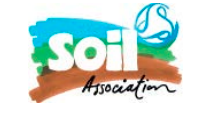
-

Robots As Everyday Tools
Written by Chris Fellows based on information from AgroIntelli

After six years of intensive work, the new generation of Robotti, the autonomous implement carrier, celebrated its world premiere at Agritechnica last year amongst as lot of other robot technology. Built by Denmark’s AgroIntelli, it’s among the first autonomous implement carriers of its kind on the market and the way they have approached farming problems is certainly interesting.
The Robotti 150D is a versatile, autonomous implement carrier, with the power of a medium-sized tractor, but without a driver. Robotti is one of the first usable robots that can be used for harrowing, sowing, mechanical weeding, spraying and so on. Outputs of up to 3ha/hr are possible, depending on the task being carried out.
“With Robotti, we are at the start of a new agri-tech era in agriculture and horticulture where autonomous implement carriers become commercially sustainable and can be integrated into daily operations,” AgroIntelli sales director, Henrik Lynge Jacobsen, said.

“Timeliness, uniformity, time savings and sustainability are the major arguments for acquiring Robotti. For example, it is lighter and the soil can carry it as sooner, helping the farmer optimise sowing time.”
Robotti is equipped as standard with a laser scanner, camera and RTK/GPS, which provides precision of +/-2cm. AgroIntelli’s Robotti 150D is an evolution of the unique, autonomous concept that the company has tested during the past year with good results. These results have now been incorporated into the new model for 2020. It is larger and more capable, with bigger wheels and 150hp. A version with 75hp, called Robotti 75S, will also be available. Among others, Robotti has already been sold to Wageningen, Ghent and Aarhus universities, where it’s part of experimental work within robottechnology.
The new large version is equipped with two 75hp Kubota diesel engines that provide plenty of power and good operating speed of up to 10km/hr. In addition, the hydraulics come with three double-acting outlets and one return outlet. It offers ample power to handle a variety of implements via its standard three-point linkage. With a full height of 92cm, Robotti can also work during crops’ later growth stages. The centre mounting and the even distribution of weight on the four traction wheels helps balance the power and efficiency. Robotti is 35-50 per cent lighter than a similar conventional tractor, significantly reducing soil compaction.
Precision and safety are high priority
Precision and safety are based on digital technology and are a high priority for AgroIntelli. Robotti is equipped with a laser scanner, camera and RTK/ GPS as standard. The security systems have built-in redundancy and function independently of each other.
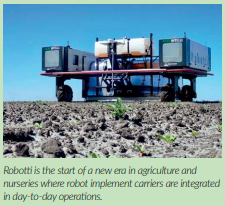
As an option, Robotti can be equipped with a number of powerful software packages, including plant counting and weed intensity measuring in the form of “weed maps”. Work plans for Robotti are managed online, where the user can use existing GPS field maps or create new ones. A computer calculates the most effective route plan to minimise fuel consumption, but also to minimise structural damage to the soil.
The log function also controls the machine history, with detailed maps stored and documented for each job. Likewise, images and recordings from mounted cameras and sensors on the autonomous robot can be stored via the logging function. During development, it was important for AgroIntelli to let Robotti operate under realistic conditions. Therefore, it’s equipped with standard Kubota engines and reliable hydraulics for low operating costs ,and easy servicing and maintenance.
Robotti is being used profitable
Henrik Lynge Jacobsen said the company’s calculations show that it pays to invest in a complete Robotti solution with tools for growing potatoes compared to a similar investment in a conventional tractor with implements.
“We have calculated the cultivation of 100ha of potatoes annually for a fiveyear period,” he added. “With Robotti, the return on investment is 181 per cent versus 138 per cent for the conventional tractor solution. This is partly due to lower labour costs and higher dividends because of less structural damage in the field.
“The robots are ready, and now it’s up to the agricultural industry to adopt the new technology.”
How AgroIntelli are approaching solutions
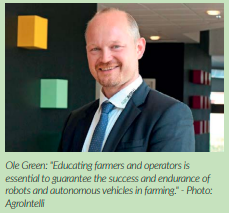
Ole Green, CEO of Danish robotics company AgroIntelli, wants his solutions to be unique and not just replicate other ideas. Looking back at what has happened historically in farming helps his team do this, he even takes them to agricultural museums. He feels that modern day farmers have got detached from the soil itself, spending more time in tractor cabins, with air conditioning far away from the soil. Farmers of previous generations would have spent far more time walking their land.
Therefore they have taken the approach with Robotti to work with implements that already exist. Thus the robotic elements add valaue to the current equipment as opposed to simply replacing it. This is a similar concept to what Continental did and was written about in Direct Driller Issue 9. However Robotti is in a much bigger scale. You can see the machinery in action via the QR Code.

-

Field Robots Meet Farmers’ Mechanical Weeding Needs During The Corona Pandemic
Written by Malene Conlong from the German Agricultural Society (DLG)
The DLG Digital robot webinar explored mechanical weeding as alternative to herbicide: Field requirements, monitoring, wear parts, solar power and remote service.

As farmers around the world face challenges in the use of herbicides in crop production, autonomous robot, capable of mechanical weeding on the field, offers farmers an attractive alternative. At the online robot webinar “Robots for mechanical weeding” organized by The German Agricultural Society on 16th June 2020, international experts in field robots from academia, research and industry discussed what is practically possible for farmers today, including using field robots during the Covid-19 pandemic.
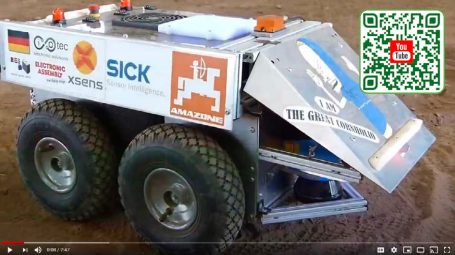
Mechanical weeding offers a solution to farmers in a number of ways. “Either the herbicide does not work as well or is not allowed anymore or, in some cases, societal pressure means some products, like glyphosate, cannot be used anymore. This is where autonomous mechanical weeding could provide a key solution,” said Klaus Erdle, DLG Competence Center Agriculture, introducing the DLG Digital webinar.
FarmDroid
Designed for fields of up to 20 hectares, commercial robots with the dual feature of seeding and weeding from the Danish company FarmDroid are already working on several European farms, having covered more than 1000 hectares in the Spring of 2020. Using high-precision geo coordinates to seed and weed, the robots are solar powered with a back-up battery and operate with 8 mm accuracy within and between rows, which means manual weeding is significantly reduced and in some cases not necessary at all”
“As a fast response to the Covid-19 pandemic one customer even ordered a second robot”, says René Jannick Jørgensen, CEO of FarmDroid, which shows that mechanical weeding robots are already considered to be reliable workers, also in a crisis.
The autonomous robot, which weighs some 700 kilos and has a working width of three metres, works both thoroughly and precisely at a steady pace of between 450 and 900 metres per hour.
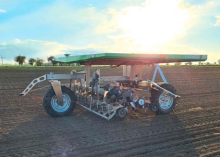
The FarmDroid can be left in the field over the season and will carry out the work by itself through its connection with the RTK station.
Arno Ruckelshausen, Professor at the University of Applied Sciences Osnabrueck, Faculty of Engineering and Computer Science, Germany, noted that there are still legal and technical obstacles that need to be overcome before field robots will overtake the herbicide solutions.
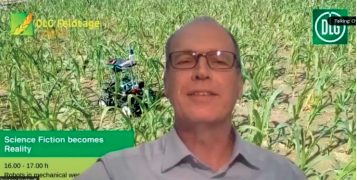
With 30 years’ experience in mechanical weeding and field robot solutions for tractor-driven implements, including various sensor technologies, Germany company K.U.L.T. (Kress Umweltschonende Landtechnik GmbH) showed that autonomous mechanical weeding in the field is possible, but currently due to legal constraints still needs to be supervised by the driver.
In fact, farmers need to be actively involved when employing a field robot. “Farmers have to make a step towards the robot too, being open-minded for new developments, but also things like security systems to make them stop if there is a problem and, of course, they need to monitor the robot. A full control of the systems is important for the future set-up on farms,” explained Christian Kirchhoff, CEO, K.U.L.T., to the 450 viewers.
Practical farming expert, Dr. Beat Vinzent, Bavarian State Research Center for Agriculture, Germany, agreed. “It is a bit like when dairy farmers first discovered milk robots. They needed some time to adjust to the fact they were no longer just dairy farmers, but needed to learn to handle the system. But in the end this turned out to be just a transition period.
“How successful the adoption of robots by farmers continues to be in the end will certainly depend on the reliability of the systems and on whether farmers own the robots or if they just buy the robot work as a service from a contractor,” added Dr. Vinzent.
Field requirements, wear parts, remote service and security
“From our experience we know that farmers are ready to adopt the technology, even many small farmers,” commented René Jørgensen, CEO of FarmDroid. “They recognize it still requires some effort. The wear parts need to be considered since minimal tillage can be hard on tools, so the farmer of course has to ensure that the parts are in good condition. Simply speaking, the same attention you give a tractor, you need to give a robot. We can track the robot any time, if required for security reasons, and we are also currently setting up a remote support centre that can identify any issue and deal with it before it become a problem in the field,” added Jørgensen.
The requirements for some robots, like the one from FarmDroid, state that the field should not exceed 10 degrees slope which is determined by the power-to-weight ratio of the robot.
Return on investment within two years
Questions from online attendees covered investments and costs
“How much do I have to invest?” “What is the return on investment?” “How high are the costs of maintenance?”
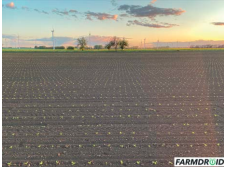
“Seven hectares and above gives a feasible business case, dependent of the crop type” explained Jørgensen. “Return on investment is less than two years in a typical scenario in which a farmer uses the robot for organic sugar beets for the spring season and then again for rapeseed, or any other similar crops, in the autumn. We have had creative farmers who have utilized it for many different crops and herbs, thus they themselves have managed to improve the business case beyond our calculations,” added Jørgensen.
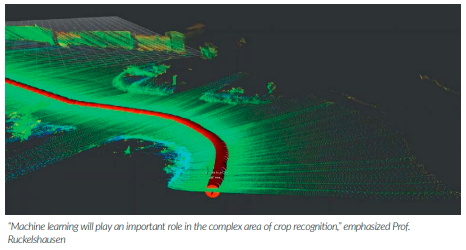
“The FarmDroid robot can be easily transported to another field using a tractor to get an even better business case by covering more hectares,“ he added.
The prices of robots reflect their functions. The field robots from K.U.L.T., which uses a combination of GPS, lidar and camera sensing technologies, range from 25,000 Euros for small ones and 125,000 Euros for larger ones with in-row equipment. K.U.L.T. supplies robot systems to Naio robots, an Agritechnica innovation awardwinner from France. The autonomous seeding and in-row weeding robot from FarmDroid is priced at 65,000 Euros. Future trends – Machine learning to distinguish between weed and crop; Swarms of robots will work as teams “Over time, field robots will learn how to distinguish more accurately between weed and crop.
This is achieved through analysis of literally thousands of images recorded by field robots that enables the distinction between weeds and crop in the field. In other words, the field robot will be able to tell what kind of crop it sees and distinguish between harmless and critical weed. With this knowledge accumulated over time, the robots will be able to compare previous experiences, which will result not just in smarter robots, but also in smarter weeding,” commented Prof. Ruckelshausen.
Other future trends noted by Prof Ruckelshausen include quality checks of the soil and plants. This could mean that field robots could specialize in tasks. One could be measuring the moisture of a plant and if it needed water, it could send a signal to another field robot, which would react and provide the required moisture. This is what has been termed ‘swarming’. The field would be equipped with several small autonomous robots that would work as a team,” concluded Prof. Ruckelshausen.

Crop residue and stone detection
A question was raised in the webinar chat about how well the robot can cope with crop residues and stones in the field. “It is only a matter of time until a robot will be able to cope reliably with crop residues,” says Dr. Vinzent, Bavarian State Research Center for Agriculture. Klaus Erdle, moderating the online webinar concluded that it was interesting to note that two companies with such diverse backgrounds and approaches both agreed on the promising future of mechanical weeding.

“What is clear from this afternoon’s session is that the farm has to make a first step in giving the technology a chance to adapt to the field. We cannot expect everything to work perfectly. “Chemical spraying is still a top technology, but even the chemical spraying discipline went through a lot of learning steps. It is fair to say that robots will go through many phases still, perfecting their skills, but right now as we have seen today, field robots show a promising solution that will impact practical farming in the future quite quickly,” concluded Erdle.
Field robot contest – a regular feature at DLG Feldtage exhibition
Field robots capable of “manual” weeding are under continual development by talented engineering students at universities throughout the world. A review of the many complex manoeuvres – weed recognition, weeding or headland turns – performed by field robots are shown in this science-fiction inspired video compiled by the DLG, the German Agricultural Society. The students had planned to let their robots perform their advanced skills in the field at the international Field Robot Event (FRE), held at the DLG Feldtage exhibition, now postponed until next year due to the Covid pandemic.
The Digital Webinar
The speaker panel consisted of:
• Christian Kirchhoff, CEO K.U.L.T. Kress Umweltschonende Landtechnik GmbH, Germany
• René Jørgensen (CEO) at FarmDroid ApS, Denmark
• Arno Ruckelshausen, Professor at the University of Applied Sciences Osnabrueck, Faculty of Engineering and Computer Science, Germany
• Beat Vinzent, Bavarian State Research Center for Agriculture, Germany
Moderated by Klaus Erdle, DLG Competence Center Agriculture, Germany
The event can be watched back on YouTube:
-

Breaking The Cycle With Groundswell Agronomy: The Future Of Agronomy Reimagined
By Richard Harding, ProCam – all views are my own

It was very refreshing to read Adam Driver’s Farmer Focus article in issue 10 of Direct Driller. In this update, Adam echoed many of the thoughts I’ve held since I began my agricultural studies. It seemed then, as it does now, that our constant desire to externalise the problem and then purchase the solution – not by any means unique to farming – is a very flawed approach. We are all seduced by technology, me included, sometimes. Which leads to the assumption that nothing, but a man-made solution is able to provide the answer to agriculture’s biggest challenges, whether they are perceived or real. This takes us back to Adam’s article and his comment about the widely purported “feed the world” narrative, which is really about encouraging increased production at all costs, rather than recognising that the reality of hunger is more about politics, the unevenness of food distribution and fundamentally historic economics.
An illustration of our addiction to technology came just last week. At the end of a long day of soil sampling – stubbles to be precise – on a sunny September autumn afternoon, I suddenly felt that sinking feeling while discussing soil sampling with a local farmer.
We were comparing the very pretty variable spreading maps that had just been produced by a local liming company, with my just-completed more random soil sampling done by hand. To my surprise the farmer was more pragmatic, and wise enough to see that while this would be perceived as progress by many it was unlikely to produce a more reliable result than my random W sampling pattern across his fields. However, what I was doing couldn’t be achieved by those specific maps. By this I mean: picking up the nuances of soil friability, compaction, getting a sense of biological activity through smell, and the general suitability of the soil for direct drilling of the next crop.
Or, what the next crop should be, based on the soil’s current state; for instance should we be sowing another cereal if there was enough friability, with or without a companion. Or should it be a large seed like a bean to restructure the slumped soil needing some restructuring with roots not iron? While I completely see the value that precision farming has, we occasionally need to ask the right questions of it and its interpretation.
I agree with Victoria Sweet’s question in her article about Slow Medicine, that sometimes it could be a case of “Is inefficiency more efficient than efficiency?” (ref. Gods Hotel by Victoria Sweet, Riverhead Books. ISBN-13: 978-0399573316).

While looking round for some inspirational words I came across something I had seen a number of years ago in Brake the Cycle, a 2013 fundraising video for the Building Man Festival. To quote from that: “Given we’ve had the cosmic shift, we are super apes, it’s time to be evolution. Let us set our hopes high, have sky aspiring ambitions and reimagine our collective potential”. While there’s no denying this year farmers are feeling jaded by the extremely difficult season just gone, we need to keep pushing forward and resist the temptation to revert back to type and do what we’ve always done. The caveat to that statement is always to do so within the risk profile of the farm business as it stands today. The only question left is how exactly do we do that, and where should the enlightened advice for this come from now and in the future?
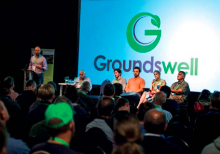
The enlightenment has come in the shape of a new agronomy service from the home of the Groundswell Show and Conference.
As many readers of Direct Driller will know, the Groundswell Show and Conference was born out of a strong desire by the Cherry family to spread awareness of Conservation and Regenerative Agriculture techniques. This involved creating a forum for learning and networking, not only for farmers but for all those who are involved in the food supply chain. While discussing the farm’s agronomy around the kitchen table at Weston Park Farm back in 2019 it seemed obvious, as there are a growing number of converts to farming in this way, that the natural next step was to provide a Groundswell agronomy and consultancy service. A service available to anyone interested in investigating or implementing anything from a complete system rethink to just one specific technique of Conservation or Regenerative Agriculture. Tailored to provide as much, or as little, ongoing support as is required.
A common request among farmers and attendees of the Groundswell Show and Conference is for advice on implementing ideas picked up at Groundswell, on their farms. Farmers often talk of feeling isolated when surrounded by peers who may not be supportive of a change to the radically different system from the one they are used to. Groundswell Agronomy approved Consultants will be able to provide the advice needed to ensure the rural farm business is financially resilient and agronomically sustainable whatever the farming system – arable, mixed farming, horticulture or mainly livestock.
“The core underlying value of the Groundswell Agronomy Service is: independent advice and knowledge transfer through industry-wide collaboration” –Richard Harding
The Groundswell Agronomy and Consultancy is made up of a national group of independent consultants offering a wide range of services which can be tailored to each unique situation and key features include:
1. Independent consultancy advice charged by the hour or day.
2. A traditional agronomy service charged by the acre with or without financial benchmarking which includes both confidential benchmarking provided by Land Family Business, charged on an area basis and membership of a regional Groundswell discussion group, which farmers are encouraged to join.
3. Trials and telephone agronomy service specific to Conservation Agriculture.
4. Practical support from experienced farmers practicing Conservation and Regenerative Agriculture.
5. Groundswell Farm – hosted individual technical events.
6. Livestock consultancy –specific to Conservation and Regenerative Agriculture.
7. Environmental Scheme planning and Direct Payment Scheme advice.
8. Facilitating Groundswell local meetings of farmers with reference to each specific regional need.
Just one example of existing industry collaboration is that of the first Groundswell Agronomy benchmarking and discussion group, facilitated by Gary Markham from Land Family business. While only in its third full year it is not only providing some reliable data on the profitability of farms practicing Conservation Agriculture it always combines discussions on the physical and financial performance of the group’s farms, striving for continual improvement through knowledge transfer.
Below are some of the provisional findings from the group’s results. We look forward to expanding the Benchmarking groups and if you’re interested in joining a group in your area contact richard@groundswellag.com
No-till/ Conservation Agriculture compared with conventional ploughbased system*:
• Capital value of machinery -£186/ ha less
• Capital value of machinery -£13/ tonne of wheat less
• Variable costs -£74/ha less
• Working capital -£260/ha less (for example £130,000 less on 500ha farm)
*Source: Groundswell & LFB Benchmarking 2018/19
One main advantage of a CA system particularly in a difficult season like 2020 has been the reduced capital required to run the farm business. Allowing the risk to be diversified over a range of non-farming activities much like a CA cropping rotation.
To be part of reimagining your collective potential with Groundswell Agronomy contact richard@groundswellag.com
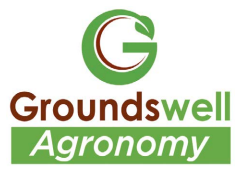
-
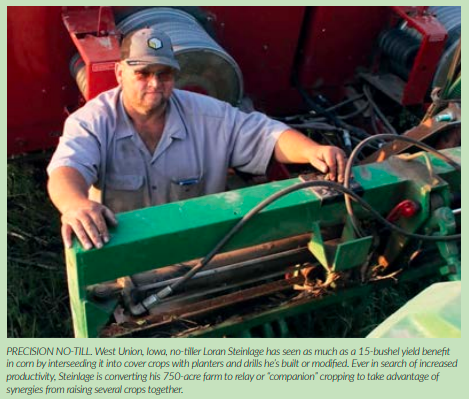
Embracing The No-Till ‘Greenhouse’ Effect
Written by John Dobberstein from No-Till Farmer USA and originally published in July 2018

From interseeding to relay cropping to ‘engineering by inventory,’ Loran Steinlage is building a profitable, divergent no-till operation
Several years ago, a trip with friends to look at greenhouses led Loran Steinlage to a Mennonite farm. It was there that he started looking at his farming practices a little differently. The farm owner had a brand new, ice-block construction house and shop and three brand new Massey Ferguson tractors. “And if you understand the Mennonite faith, they don’t borrow money, so he’s making some serious money on 20 acres,” he told attendees at the National No-Tillage Conference in January. “From that time on, I’ve really been trying to focus how we do things on our farm.”
And Steinlage’s farm doesn’t look like most others in his state. Soil tests, crop yields and even infrared videos from his fields are proof enough that no-tilling, cover cropping and alternative planting systems are improving his farm’s soils and profitability.
On the Fringe
Steinlage’s 750-acre farm sits in the northeast corner of Iowa in the Paleozoic plateau, on the edge of the glacial-till line. His area only sees 140 frost-free days, and he estimates his fields have at least two dozen soil types.
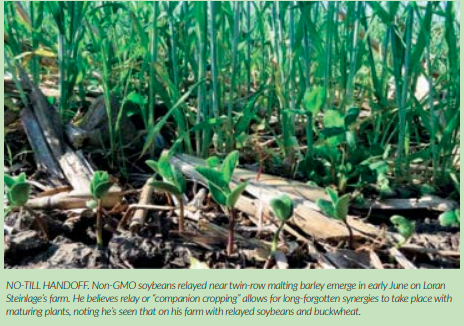
Steinlage used to raise continuous corn for many years, but rootworm resistance and weed issues started building up. He began working more closely with the NRCS in 2006 and since has brought soybeans and winter wheat back in the rotation. This year he replaced Roundup Ready corn and soybeans with 100% nonGMO hybrids and varieties. He also raises barley, winter wheat, cereal rye and buckwheat for cash crops, and rye and wheat for seed. Steinlage no-tills corn around April 17 at a rate of 21,000-38,000 seeds an acre, although he saw later planting dates this year with his non-GMO hybrid.
Because Steinlage variable-rates all his seed corn, using a DigiFarm RTK guidance, “we automatically get variable-rate cover crops because the covers thrive when you drop that plant population down to 21,000 to 24,000,” he says. “Where do we need the covers to be better? On the gravel knolls. We’re monitoring and seeing how fast we can gain soil organic matter on our hills.”
Steinlage typically interseeds cover crops into corn when it’s at the V2-V3 stage. He rarely runs the interseeding units any slower than 10 mph, usually shooting for 11-12 mph. He shifts corn planting over 5 inches so no changes are needed for the seeders or his John Deere 8400T tracked tractor. Over the last decade, he’s tried various combinations of interseeded covers, including clover; annual ryegrass, red clover and radish; cereal rye, winter wheat, lentils and sweet clover; dwarf-Essex rapeseed, crimson and balansa clover and oats; phacelia, buckwheat, hairy vetch, flax and winter peas; faba beans and chickling vetch; and meadowfoam.
When growing corn on corn, he interseeds clover or vetch. As his rotation has changed, Steinlage often seeds winter wheat into soybean stubble going to corn and cereal rye into corn stubble going to soybeans.
A Big Shift
Although Steinlage has been known for his interseeding prowess, he’s in the middle of shifting much of his operation to relay cropping, or what some refer to as companion cropping. It’s the practice of planting different crops in proximity for pest control, pollination, providing habitat for beneficial creatures, maximizing use of space, and to otherwise increase crop productivity.
Many of the modern principles of companion planting were present many centuries ago in cottage gardens in England and forest gardens in Asia, as well as thousands of years ago in Mesoamerica.
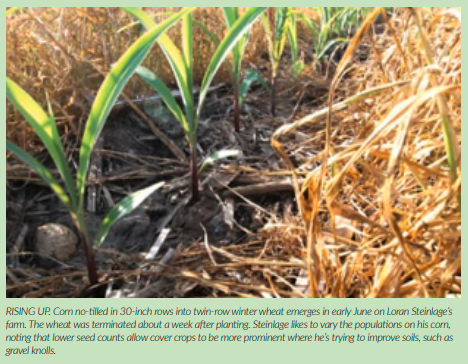
“The biggest thing I see on companion cropping is productivity. I want my cover crops paying. When I committed to cover crops, that’s where I started and that’s what I’m going to stay with,” he says.
Steinlage is in his fourth year of relay cropping on a field scale. He began investigating synergies between different crops planted together several years ago, noting the productive ‘Three Sisters’ plantings by Native Americans of corn, soybeans and squash. Soybeans he planted in his own greenhouse in this manner that were supposed to be 12 feet tall grew 18 feet high.
This year, due to switching to non GMO corn and soybeans and planting later, Steinlage interseeded about one third of his acres — mostly corn — with cowpeas and is relay-cropping the remaining acres with summer legumes. He typically sidedresses corn with N with his interseeder at V7-V8. The DigiFarm RTK system in the tractor lets Steinlage shift rows over 5 inches to place seeds right next to the old plant into minimal residue.
He’s found relay cropping can be very profitable compared to traditional notilling methods. A projection budget he shared this year showed 30-bushel cereal rye and 30-bushel soybeans, paying at $10 a bushel each, and 400 pounds of buckwheat could make him $660 an acre, which he feels compares favorably to 200-bushel-an-acre corn.
“The scary part is I know we can double those numbers,” he says. “Do I have to farm the world? No, just got to farm smarter.”
This year, Steinlage reduced his corn acres and focused on interseeding and relay seeding more warm-season legumes into his cash crops, taking some inspiration from his friend Chris Teachout, a veteran no-tiller and cover crop experimenter from Shenandoah, Iowa.
Teachout last year managed a warmseason legume interseeding test plot on his farm for Practical Farmers of Iowa where less than 40 units of nitrogen (N) was applied to corn. There were three replications of corn interseeded with cover crops, but in one area there was an early primer of cool-season covers that included brassicas ahead of corn. Corn that followed the primer cover crops and was interseeded with treatments of fava bean, cowpea, corn/ soybean/squash and sunnhemp all yielded 200-213 bushels an acre with just 40 pounds an acre of N applied, the study data shows. A test strip with the primer covers, but nothing interseeded, yielded 190 bushels.
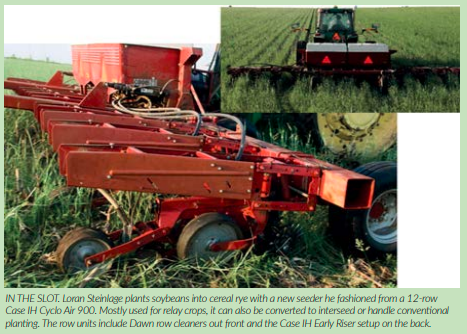
Workshop Creations
Grand plans for interseeding or relay cropping don’t become a reality until no-tillers have a planter or drill outfitted properly to deposit seed accurately and maximize emergence. Steinlage got his start with interseeding systems several years ago when he used a small Agri-Fab spinner box pulled behind an ATV to seed cover crops into corn seedlings. Since then, he’s gone through several different toolbars that he’s modified for interseeding.
An early interseeder model used 7 years ago, while he was still strip-tilling, included a toolbar mounted with a Gandy air seeder. It was used to interseed up 80 acres of corn, but the machine proved to be too small to expand the practice.
He later revived an old 30-foot Hiniker drill that was adapted for twinrow seeding of cash crops and cover crops. It was later sold and he used the money toward his next machine. In 2016, Steinlage worked with Dawn Equipment to build an interseeder comprised of a Dalton toolbar and the company’s DuoSeed Cover Crop InterSeeder row units from Underground Agriculture. Dawn also helped provide some modifications to allow for rowcleaner mounts for Dawn row cleaners, seed firmers and a Precision Planting 20/20 monitor.
Steinlage made further improvements, creating an in-row roller attachment for the DuoSeed units to roll down cover crops and interseed at the same time, saving time and fuel. Steinlage started using it to interseed annual ryegrass, cereal rye, clovers and other cover crop species into corn that’s generally at the V4-V6 stage.
He runs the machine with a Hiniker box to drill soybeans, then switches the box out for a Montag to interseed covers and sidedress nitrogen. The interseeder also includes poly selfadjusting row cleaners.
“With the Montag tank I can dump four totes of seed in there and we go to work. We’re drilling cover crop seed, we’re interseeding with it and we’re doing all our fertilizer application with it,” he says. Adding this advice, “If you want to make a piece of equipment pay, build it with some versatility so you can use it.
“If you want to make a piece of equipment pay, build it with some versatility so you can use it…” — Loran Steinlage
Never one to accept the status quo, Steinlage rolled out yet another seeding device in June, a 12-row Case IH Cyclo Air 900 that he modified to mainly handle relay cropping. But he can also interseed or do conventional planting with the machine. The row units include Dawn row cleaners out front and the Case IH Early Riser row-unit setup on the back.
A big key to the planter’s setup is a Sukup Slide Guide that he modified to shift 15 inches in either direction, allowing the machine to do relay, interseeding or regular no-tilling.
Steinlage also owns a John Deere 1760 corn planter that he’s modified with precision technology, parallel arms with bearings that he built himself and Shoup Mfg. Co. cast-iron row units. Despite the changes in equipment and associated costs, Steinlage says the cover crops are paying their way. He reports an average 15-bushel increase in the current no-tilled corn crops when they’re planted into cover crops.
‘FLIR’ry of Data
Steinlage says he’s gathered some interesting data on the impact his no-till system is having on his soils and popular assumptions made about cover crops by farmers and experts in his northern climate. On one field he’s been interseeding for several years, soil tests show the percentage of water-stable macroaggregates in the soil is at 70% on a 5-year basis, on par with restored prairie and up 30 percentage points from levels typically seen in fields with continuous corn. Pasture grasses and prairie remnants score in the 90% range. Soil organic matter levels range from as low as 1.7% in gravel knolls to 6% in his better soils. He’s found through soil biology tests that recovery of organic carbon on his farm has been slower than with recovery of soil aggregates, he says.
Soil Temperature Measurements
One of the myths often repeated about no-till and cover crops in the Upper Midwest is that residue left in fields in the spring before planting makes soils colder and wetter, requiring tillage to warm soils up. Wanting to find out for himself, in 2016 Steinlage bought a forwardlooking infrared (FLIR) camera for his iPhone to take heat measurements in his fields, even doing side-by-side comparisons with his farm and a neighbor’s. Steinlage has infrared video from March 2016 of a field on his farm with cereal rye and soybean stubble next to a neighbor’s tilled, ripped soybean stubble. The video shows soil temperatures as high as 47 F on Steinlage’s field vs. temperatures as low as 37 F in his neighbor’s field where the soil is more bare.
Another experiment where Steinlage raked residue away from a 10-by-10- foot plot in one field showed soil that was no-tilled and cover cropped were as high as 46-50 F, and as low as 36-42 F in the uncovered plot. Steinlage says no-till residue and cover crops provide a beneficial insulating effect. Data from soil probes he inserted at a 4-inch depth has also shown soils were warmer in areas with covers in spring than uncovered soils, until equipment passes made temperatures spike cooler, he says. As warm weather arrived, the canopy kept soils cooler and the soil got warmer again after harvest.
“We make people scratch their heads pretty hard, with the results” he says
Is Wider Better?
Steinlage is also looking for a way to get livestock back on his operation. But as you might expect it won’t be the conventional way. A couple of years ago he was invited to visit some farms in Ireland. While there he noticed the large amount of sheep used in grazing systems, with corn planted to 40-inch spacings so the animals could fit between the rows. Hoping livestock will allow his daughters to help manage the farm when they return, Steinlage started working with consultant Bob Recker of Waterloo, Iowa-based Cedar Valley Innovation on experimenting with different corn populations and row configurations that could lead to livestock grazing in living corn.
Recker is working with 14 growers in Iowa, Illinois, Wisconsin, Minnesota and Ohio on wide-row concept test plots for 60-inch rows. The wide-row system is defined as omitting one row to provide added sunlight to corn and interseeded cover crops. No-tillers turn off every other row on a traditional 30-inch row corn planter and double the perrow population in the other rows.
Plot work last year showed either a small or no yield penalty for 60-inch corn if populations were doubled in the 60-inch rows with the number of seeds per acre remaining the same. Where cover crops were used, the 60-inch rows significantly increased growth of the cover crops compared to 30-inch rows. On his plot last year, Steinlage planted two rows of 30-inch corn at populations of about 34,000 seeds per acre, skipped a row and then planted two rows of 60- inch corn with populations over 50,000 seeds an acre. His corn yields for 60-inch rows were 230 and 223 bushels an acre, but 213 bushels for 30-inch rows. Steinlage says those numbers compared favorably to 30-inch corn with or without cover crops on other farm plots Recker studied.
Recker also oversaw experiments with 60-inch monocrop corn and the resulting yields of 221 to 238 bushels an acre also exceeded expectations.
One goal of the wider rows is to allow access to the field any time of the year, which would be beneficial for high-clearance equipment, companion cropping or possibly grazing.
“If you can grow 60-inch corn and equal 30-inch corn and eventually have a grazing opportunity, isn’t that something you’d look at?” he says.
-

Base UK
We had a busy start to 2020 with members visiting Agrovista’s Project Lamport site on a cold and windy day in early February where Niall Atkinson and David Purdy talked about the results so far on soil management, soil structure and biology of the trials. Philip Wright added more detail on cultivations. They also visited a field of OSR where establishment plots with and without companion plants told a clear story on how adding diversity rather than mono-cropping can bring benefits.

This was followed by our annual conference and AGM on 11th and 12th February held in York. This was a great success attended by 150, with a wide variety of speakers discussing subjects as diverse as mob-grazing to how the mindset of farmers dictates how they cope with changing their systems from conventional to CA. A delicious dinner was followed by an intriguing quiz on seed types kindly provided by Ian Gould and we celebrated the 21st birthday of one of our newest members, Donald Christie.
Sadly, our next events were put on hold due to the Covid 19 situation and it has been really disappointing not to see one another at shows, farm walks and other events and visits which had been planned by the Committee. Once it became clear that the social distancing rules were not going to be lifted any time soon, the Committee took up the offer of setting up a BASE-UK Members Only Forum, hosted by The Direct Driller which has proved to be quite successful.
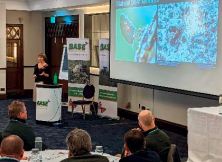
The Committee also decided that to provide members with some interaction it would be great to hold some online meetings and these have proved a big hit so far. In July Kelly Jowett from Rothamsted Research provided a fascinating presentation on Carabid Beetles and in August James Warne from Soil First Farming discussed Cover Crop Strategy and The Path to Conservation Agriculture. These were loosely based upon his articles written for The Direct Driller magazine but also gave members an opportunity to open the discussions further. Whilst we planned for these to last an hour, the discussion went on for much longer.
As I write this we have just held another online meeting with Robert Brewster (who spoke at our AGM Conference and had planned to host a visit to his farm in Scotland) presented on how to Build Soil Health with Mob-grazing. This proved inspiring to those with and without livestock and we hope that our planned trip will take place sometime in the future.

SAVE THE DATES:
Going forward we have plans for more meetings for members including:
• 14th October – David Purdy and Mark Hemmant from Agrovista discussing Project Lamport results and what the future holds for this trail.
• November – date to be confirmed – members meeting with Adrian Newton from The Hutton Institute and Henry Creissen from SRUC presenting on IPM as a concept and practices under CA systems. More details will be sent to members in due course.
• We have invited Frederic Thomas from BASE France to present an online meeting (it is not likely he will be able to get to us from France any time soon!) – again the date is to be announced.
• 9th and 10th February 2021 – AGM Conference at The Park Inn by Radisson in York – Covid allowing!
BASE-UK, within its membership has unparalleled, impartial, practical expertise in the field of conservation agriculture which is not only openly and widely available to members embarking or contemplating initiating ‘regenerative’ practices on their own units but also caters for the more ‘well-seasoned’ practitioners.
Membership is for individuals and if you would like to know more about us please visit our website
www.base-uk. co.uk or email rebecca@baseuk.co.uk for membership information.

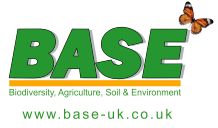
-

Drill Manufacturers In Focus…
STRIP TILLAGE BEST PRACTICE

At Mzuri, we champion sustainable establishment, and we believe strip tillage answers the questions that many growers are now asking to improve their yields, promote healthier soils and reduce operational costs.
We pride ourselves on supporting our customers and so we’ve shared our top ‘Best Practice’ tips that help growers get the best out of the Mzuri strip tillage system:
• Correct strip tillage technique starts with the combine. “By failing to prepare, you are preparing to fail,” an old maxim which is also true for strip tillage. Good practice starts with preparing the perfect “canvas” to drill into and this means ensuring the field is “striptill-ready” at harvesting. We recommend an optimum stubble height of 150-250mm to ensure it flows well through the Pro-Til. An even distribution of chopped straw and chaff is also desirable as uniform mulching around the field is paramount for ensuring good moisture retention and availability of material for earthworms to turn into nutrients.
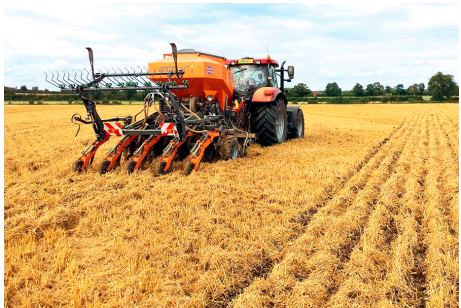
• To chit or not to chit? Although the Pro-Til will happily drill directly into surface straw in a one pass operation awarding excellent residue clearance, some growers may prefer to create a stale seedbed prior to strip till drilling. This is particularly pertinent for farms with a blackgrass or slug problem or for users who wish to accelerate straw decomposition. In this situation, we recommend the Rezult straw rake. It features five-rows of extra stiff tines with the option to fit a set of leading discs. The result is a nice, light tilth creating the perfect stale seedbed.
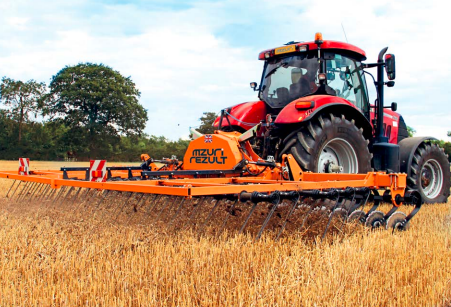
• Get the light right. Good light interception from early growth stages is key to strong plant structure and high yields. The stubble height of 150- 250mm is ample enough to shield the crop from cold temperatures and winds yet short enough to ensure the plants get sufficient light, providing an optimum micro-climate.
• Leave the surface straw… on the surface. Leaving previous crop residue on the surface helps retain moisture, reduce erosion, and improves organic matter.
• Give the seed the best start. The secret to fast and successful seed germination is good seed to soil contact for instant availability of nutrients and moisture. Soil must be reconsolidated to eliminate the air pockets leaving friable, fertile tilth to give the seed the best start. This is what the Mzuri Pro-Til does exceptionally well thanks to its combination of unique, patented features. The auto-reset tines produce the perfect tilth with the option of placing a band of fertiliser just where it is needed, followed by the reconsolidating wheel. The coulter tool bar works totally independently to the cultivation zone, ensuring easy adjustment and constant seed depth control. Each coulter hydraulically exerts pressure to each of the seed depth wheels to ensure accurate seed placement and excellent soil to seed contact. As a result, the crop can get away quickly and grow to achieve its full potential. • Understand your soil. One size does not fit all and so we recommend you should look to tailor the equipment to best suit your specific conditions. We offer a range of front leg options to easily adapt to any type of soil, including a choice of front discs and leading leg configurations. The optional front discs cut through surface residue and help to create a tilth with minimum soil disturbance. The choice of the cultivation leg and wing tips control the tilling depth and profile. Wider wings are typically fitted when seeding with a wide band coulter whereas narrow wings are best suited for drilling with a narrow coulter in harder ground. • Select the correct seeding coulter. Not only is there a whole host of options to tailor to the soil, we also offer a range of seeding coulters to suit the crop too. Wide band seeding is recommended for wheat and barley whereas narrow band seeding would be better suited for oilseed rape and beans.
• The choice of wheels is also important to ensure the right amount of pressure is exerted. The Pro-Til can be supplied with a wide or narrow wheel profile to match the coulter and soil type. Dry soil conditions need slightly more pressure to ensure better seed to soil contact whereas drilling in wetter soils requires a lighter approach in order not to cap the soil. • The final touch. The Pro-Til is supplied with a harrow bar which produces the perfect smooth finish for better coverage of pre-emergence herbicides. Some users prefer to keep the tilth profile untouched in order to create a microclimate which can be up to 2-3°C warmer in the ridges – a practice which is particularly popular in colder climates with freezing winters. The slightly raised contours of the ground coupled with the surface straw each side of the crop row provides shelter from wind damage and subzero temperatures. This practice can ensure a viable crop where conventionally drilled crops would often fail in the same conditions.
• Rotation, rotation, rotation. At Mzuri, we promote a minimum 4-year rotation to increase crop health. The changing of crops in a sequence reduces their resistance to chemical, builds up plant resilience against disease and helps to combat persistent weeds. With the ProTil single pass system promoting better establishment, users can feel more confident to include spring crops into their rotations, whilst we actively encourage users to experiment with cover crops and companion species for greater diversity and soil health benefits.
For more information on the Mzuri strip tillage system visit
www.mzuri.eu or call 01905 841123 -

Soil Farmer Of The Year Winners Announced
The Soil Farmer of the Year competition has been running now for the last five years and aims to find, promote and
champion those farmers who are putting soil health at the centre of their farm business management. This year the
competition has been slightly challenging to run due to the COVID pandemic and the inability to conduct judging in
person. Our finalist farmers all did a magnificent job at creating videos detailing their individual farm journey to sustainable soil management as well as enduring a virtual grilling from the judging panel to decide the results.The top accolade this year has been awarded jointly to two farmers, Jake Freestone from Overbury Farms and Alex Brewster from Rotmell Farm. Both farmers were doing amazing things around soil management in very different locations and settings. Our third place farmer this year was John Martin, an arable farmer from Dorset who has been working on soil management for over 20 years. Normally by this time of year the farms walks have taken place and this article is a write up of the discussions that ensued, however this year things are a little different. The farm walks will be taking place in October, with some online and some in person with the required safety guidelines. All the information about the farm walks is available on the Farm Carbon Toolkit website (www.farmcarbontoolkit.org.uk). So its probably time to meet our winners for 2020!
Jake Freestone has been managing Overbury Farms since 2003. The farm sits within the wider estate on the Gloucestershire / Worcestershire border and is a mixed farm with 1600 ha of farmland, both permanent pasture and arable cropping, some land let out for vegetable production and a flock of 1000 ewes. The soils are incredibly varied on the farm from Cotswold Brash to an Evesham Clay series, and the farm has a diverse and wide rotation to help deal with the variety. The rotation includes wheat, spring barley, oilseed rape, peas, beans, linseed and quinoa. Jake started focussing on soil health and looking at adapting management following his Nuffield scholarship, working on a reduction in cultivation, improving organic matter and diversifying the rotation.

“Switching to no till has given us huge soil health benefits on the farm,” Jake explains. “It’s enabled us to grow bigger and better cover crops, that we can drill straight into which is reducing our costs, but also improve the soil structure and the organic matter. Especially on our stonier soils, we aren’t having to move the stones as we were previously when we were cultivating conventionally, and the soil structure is also protected, helping with water infiltration which is key on this farm as we supply the nearby villages with drinking water. Other benefits come from a reduction in weed burdens and the ability for the farm to support enhanced biodiversity, so no till is really a crucial part of the jigsaw.”
Cover cropping is integral to the farm system that Jake is running. A diverse mix of species is planted which effectively captures sunshine, help structure the soil and feeds the soil biology. The cover crops are also helping to reduce soil erosion by effectively capturing rainfall. Future plans include more integration of the livestock into the system to graze the cover crops and optimise the benefits that they bring in terms of soil health and biology.
Jake is seeing the benefits that these changes have made both in terms of improved soil health and structure but also a reduction in costs. Benefits include the soil being easier to work with which has led to a faster work rate and a reduction in diesel costs. Water infiltration is enhanced and there is a large reduction in runoff and erosion, with any runoff that does happen being clean water. Jake is seeing more insect life and reduced pest issues alongside no insecticide use and has managed to reduce both nitrogen and phosphate fertiliser rates.
The journey hasn’t reached an end though and there are more innovations and experiments planned including the use of a fertiliser tank on the front of the drill to apply biological inputs at the time of drilling. Other experiments include companion cropping and looking to optimise integrated pest management and a continuation of the reduction in Nitrogen fertiliser usage across the farm.
Jake explains, “Ultimately we are trying to use all the tools that we have to improve soil organic matter, water infiltration and wider water management, soil structure and soil biology to achieve the long term goal of improving our resilience both for our crops, our business and our soil.”
Alex Brewster farms at Rotmell Farm in Perthshire. The farm is an upland beef and sheep farm with 200 breeding cows and a flock of 700 sheep. The farm occupies just under 1000 ha with 130 ha of that being improved pasture based on a sandy clay loam soil and the rest being rough hill ground with typical upland soils.
Alex has been working on building the biological capacity within the soil through the use of rotational and mob grazing systems. Starting out with a transition to a rotational grazing system, this has now adapted and is a hybrid mob system with a focus on improving the diversity of plants within the pasture. Other goals are to improve both soil organic matter and pH through the use of animals, and to build a deeper root depth and mass to allow the plants to access slightly warmer soils and moisture found deeper in the soil when temperatures drop in the winter. Soil temperature is the biggest limiting factor to grassland production, so by allowing the plants to root deeper and providing a cover on the soil through trampling some of the grass down, the soil can be protected from the weather and stay warmer for longer. This also transfers some of the carbon to the lower soil layers.
Alex is also focussing on improving the hill ground and explains, “There is a huge capacity to improve the potential of the quality of some of our upland areas and the nutrition that this ground provides. We are working on sub dividing bigger blocks of land into hill paddocks, we are working on animal impact, building fairly tall grass covers, and then eating off 50% of the grass and trying to trample the rest back in to recycle the nutrient of the remaining 50% back into the top soil.”
The increase in diversity is key to the whole system. By increasing the diversity of plants within the grass leys, there is an increase in leaf sizes, grass heights and densities which is more efficient at capturing sunlight which can then be turned into red meat. We want to create a system that optimises the feed value of this plant.”
He is seeing the change on the farm especially over the last few of years. The rooting depth has been increased dramatically and the amount of friable soil is increasing to depth. Alex is seeing an improvement in water retention and improving worm numbers. This is all leading to an increasing resilience to extreme weather patterns. However as well as benefits from soil health, there is also a productive benefit arising with the grass remaining greener for longer and the farm being able to keep stock out for longer than in previous years, while at the same time carrying a higher number of stock
Alex is looking at fields where there are issues with weeds and trying to use analysis and knowledge to understand where there might be an imbalance, and work to try and rebalance the system. One of the strategies that he is employing is the use of a diverse mix of plants in a bespoke forage mix which is used as a break crop that provides winter feed but also provide a diversity of plants which will then start to manage these soil imbalances. The theory is that if we can get the soils correct, then the weeds will drift away
This rebalancing is also being seen in the forage, both in terms of improved grass yields but also mineralisation from forage analysis. Alex completed regular forage analysis and then targets the minerals for the cattle to address any imbalances found in the forage. He is seeing the benefits both in terms of animal performance but also in the pasture, with a larger rooting depth and root mass within the soil. The results are clear to see as Alex explains, “we’ve doubled cow numbers in the last 5 years but we are actually using less bagged mineral than we were 5 years ago.”
There are more plans in the future to continue to evolve and hone the system to achieve Alex’s aim of managing a beef and sheep farm which is totally carbon positive, promoting the benefits of animal impacts in land management and the relationship between rumen microbiology and soil microbiology.
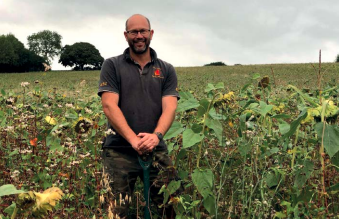
Alex concludes “The Future of farming is this absolute linkage between the total nutrient system. Its total nutrient of soils, total nutrient of pasture, and of red meat produced from these pastures and how these red meats then feed back into the food chain. It’s a really strong story that’s positive and beneficial for the future understanding what food production really should be.” The farmer that came in third place in this year’s competition was John Martin. John farms 300 acres in Dorset on an all arable rotation with two thirds of the farm in spring cropping. The farm was a former dairy farm until 2000, and since then the overarching aim of the management has been to keep the soil status in good health. John’s farm is situated in an area with a high degree of designations on it, being within a Class 1 Soil Protection Zone, an NVZ and the Poole Harbour Catchment, meaning that there has been a large focus on efficient nutrient use, especially on nitrogen.
A key strategy employed on the farm to boost soil health and also to help capture nutrients has been the use of cover cropping. All of the land that is in spring crops has a cover crop before it, and John has been experimenting with increasing the diversity of the mix. The mix now includes sunflowers, buckwheat, phacelia, linseed, and various clovers to ensure that the soil biology have a diverse diet. John explains “its like taking a coach party of people to a fish and chip shop, some will want fish, some sausage and some pie and chips. All of the soil bugs bring something to the party and are all important, so we need to provide a diverse food supply for them so they can do their jobs.”
John is farming on chalk soils and enjoys the challenges that this soil type can bring. He first started looking at soils in the 80s, digging his first soil pit in 1985. This then prompted a move towards bigger, low ground pressure tyres and focussing on axle weights of machinery to minimise compaction. There is always a spade in the tractor allowing John to assess the structure of the soil at two key periods in the year; in winter when the soils are wet, to assess how the drainage is doing, and then after cultivation to see whether the machine has achieved its goal.
The chalk soils mean that John is keen to build resilience in his soils to aid water retention. A key strategy is focussing on returning organic matter to the soil to build humus. All of the crop residues are chopped and returned to the fields and 75% of the farm is cover cropped to ensure that there is something growing all year round. When John started his transition to enhanced soil management he took some baseline soil samples. He explains “We tested fields for organic matter and they weren’t bad, but we wanted to get another 1 – 1.5%. If we can get hold of that then we’ve got more resilient soils to do spring cropping. We can tell that we are moving in the right direction as the soils are much more springy. That elasticity is coming from the humus and the soils are developing the resilience to carry us through.”
John’s focus on his soils is linked to his overarching aims for the farm which is to develop a more sustainable way of farming with consistent yields. He is involved in a range of applied research projects on the farm, including the ASSIST project, planting flowering strips through the middle of fields to aid in beneficial insect populations and an exciting project looking at reducing leaching from peas through using cover crops with Wessex Water.
Michael Kavanagh and Ian Waller were both awarded highly commended in this year’s competition. Michael is farm manager near Wolverhampton and has been totally dedicated to improving soil management over the last five years with amazing results in terms of resilience, profitability, nutrient cycling leading to a reduction in plant protection and fertiliser use.
Ian Waller farms 450ha in Buckinghamshire on an arable rotation that has incorporated cover crops, and is using innovative drilling methods and hasn’t applied insecticides for 5 years. He is a passionate advocate for soil management and its role in wider conservation and is constantly trying new things.
For more information on the farm walks please visit
www.farmcarbontoolkit.org.uk -
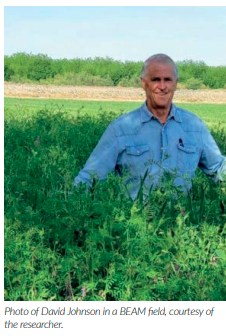
Soil Carbon Sequestration Is A Natural Consequence Of Doing Things Right
“This interview was originally published by Rodale Institute, and is part of a series of interviews to inform their new
white paper, “Regenerative Agriculture and the Soil Carbon Solution,” published September 25th at RodaleInstitute.org/Climate2020.”A conversation with microbiologist David Johnson, PhD about the role of soil health in carbon sequestration.
Rodale Institute’s updated climate change white paper, “Regenerative Agriculture and the Soil Carbon Solution,” will be published September 25th. To learn more, visit RodaleInstitute.org/Climate2020. We’re in the process of updating Rodale Institute’s Regenerative Agriculture and the Soil Carbon Solution white paper and we wanted to learn more about the very promising results achieved with your BEAM system (Biologically Enhanced Agricultural Management). Can you explain what the BEAM system is?
BEAM is looking at agriculture from a different perspective: instead of chemical, looking at it from a biological perspective, to enhance the microbiological soil profile. The farming practices we’ve adopted over the past 150 years have been damaging to soil microbial communities.

The first thing they really wiped out was the fungal community, which does both logistics and communication in the soil system. If you wanted to start a war, what would be the first two things you’d take out? Communication and logistics; it would be crippling, and that’s what we’ve done in agriculture. From there, the herbicides we’ve adopted are damaging to the structure of the bacterial community as well. We’ve hamstrung the soils we’re working on, to where they’re now living on life support.
When we bring the soil biological communities back, they have a phenomenal effect on productivity. Soil is a living organism, and you have to feed this organism. That means you have to have crops growing continually, either a commodity crop or a cover crop. Crops shuttle the energy from photosynthesis down to the soil system, as sugars, proteins and amino acids, which allow these organisms to survive.
The soil community is not that different from us. We depend on energy from the environment we live in. If we don’t have much energy, we’re basically caveman. If we start to add energy into the system, we get the ability to reproduce better; a little more energy into the system, we start to see the dynamics of diversity, start to develop different talents; a little more energy into the system and we start to see a synergy, where we’re building up a complete community that has functions far above what any single organism would have. Since we have stressed the soil so much, we’ve really reduced the photosynthetic capacity of the soils.
When we bring the biology back into the system, that capacity rises—we see more carbon use efficiency because a lot of the energy that’s flowing down into the soil is being turned into biological life. That biological life in turn harvests the elemental nutrients out of the soil parent material or fixes it from the atmosphere. We’ve observed that as you keep building this system up, it gets better year after year. I did an initial BEAM compost inoculation—not a lot of compost just a dusting—on a field and as long as we kept cover crops growing on it, the productivity improved year after year after year. We saw a five times increase in that field’s productivity within just a year and a half.
That’s a big increase in productivity. Was the difference between the treatment and control just the one compost inoculation? Or were the cover crop or other system components different too?
That’s just from the compost inoculation alone, the five times increase from the year and a half mark. The system started to rebuild itself. Now, in that experiment we were putting everything back into the soil because I was trying to see, if there was a price on carbon and a farmer was going to dedicate himself to getting paid for the carbon sequestration, what could he do if he just put everything back into the soil? That’s where I also observed a quarter percent increase in soil carbon per year.
In a different experiment, we are comparing conventional no-till corn production using 250 pounds of nitrogen per acre to a BEAM treatment, where we reduced that nitrogen by 85% down to about 38 pounds of nitrogen per acre and added two pounds of the compost per acre as an extract injected into the furrows as we planted corn. Through the microscope, we saw we were putting in about 80 million bacteria and 10 million fungal spores per square foot. At the end of the year, there was 218 bushels of corn produced on the conventional plot and the same amount on the BEAM using 85% less nitrogen. On the plot with BEAM only, no nitrogen, we saw a 6.6% reduction in productivity. This was with only one cover crop in the fall and then we came in with the corn planting. So, in the BEAM system there’s 140 plus pounds of nitrogen that came from somewhere. As you bring the biology back, you can start to forego a lot of the amendments you were putting in.
It seems like the BEAM compost is effective with just a one-time application. Why do you think this is so different than an average compost in terms of its practical application and longevity? Especially for smallholder tropical agriculture, making and moving enough traditional compost around is not technically or economically feasible, but maybe BEAM compost is?
Nature doesn’t go out and turn the compost pile, it’s a static process. That’s what we envisioned with the JohnsonSu Bioreactor compost. It’s static, so it’s never touched, never turned. We keep it at 70% moisture content, which is ideal for fungal growth, and we incorporate worms in it after the temperature gets down to 80 degrees Fahrenheit. It’s allowed to mature over one year and it will turn into a clay-like consistency that can be applied as an extract when planting. At this point, we do recommend applying it every year until we know more. It can also be sprayed on as a seed coating and the seeds are fed normally into a hopper at planting.
We designed the Johnson-Su Bioreactor to make fungal-dominant compost, and we wanted it to be accessible all over the world. Now it’s in India, Pakistan, Sri Lanka, Fiji, Africa, Chile, a lot of Europe, Russia, Siberia, Brazil and we’re starting to get positive reports back. It’s economical, and it kickstarts soil systems. We see a lot of happy farmers that have moved towards looking at soils differently, they’re more profitable, they’re more productive, it’s showing benefits.
On those benefits, what have you seen in terms of BEAM’s soil carbon sequestration’s potential to mitigate climate change?
Soil carbon sequestration is just going to be a natural consequence of proper farm management and proper grazing management. The average dry biomass growth on farms is about 600 grams per square meter. In the most productive ecosystems, nature’s doing 2200 grams dry biomass per square meter, without any amendments. In a desert soil, using the BEAM system we saw it go to 3200 grams per square meter. No farmers get that, but the possibility is there.
Bringing the soils back, having them be more productive and having them capture more carbon will take care of atmospheric carbon easily. We can take care of fossil fuel emissions and it’s just a natural consequence of doing things right—getting the biology back and regenerating soil systems so they function properly.
